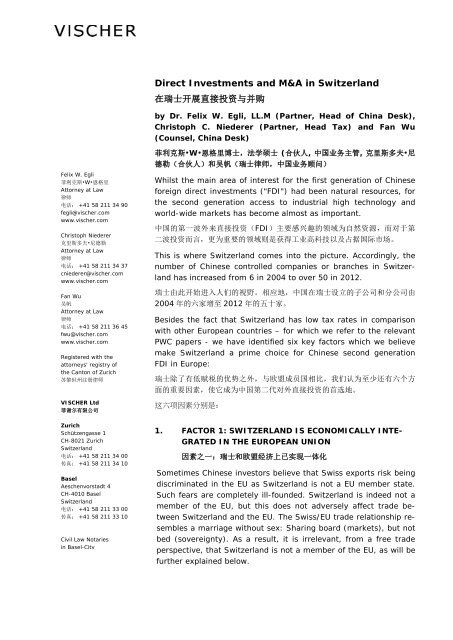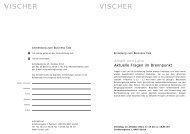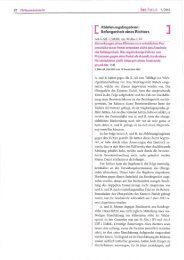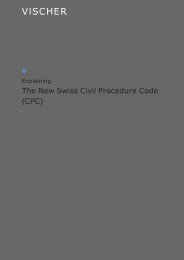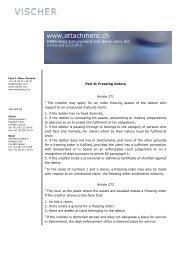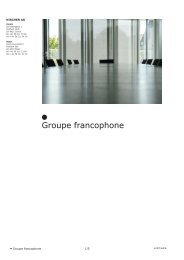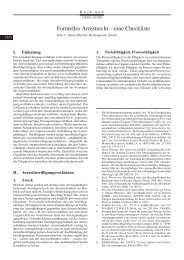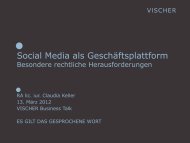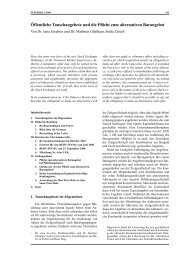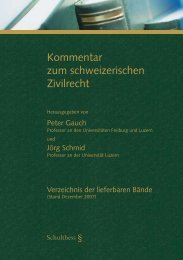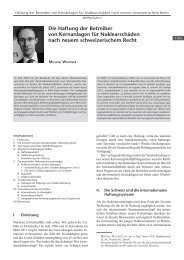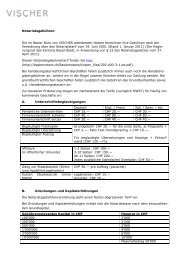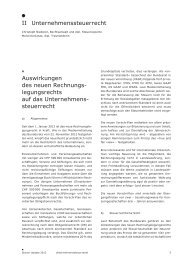Direct Investments and M&A in Switzerland 在瑞士开展直接 ... - Vischer
Direct Investments and M&A in Switzerland 在瑞士开展直接 ... - Vischer
Direct Investments and M&A in Switzerland 在瑞士开展直接 ... - Vischer
You also want an ePaper? Increase the reach of your titles
YUMPU automatically turns print PDFs into web optimized ePapers that Google loves.
Felix W. Egli<br />
菲利克斯•W•恩格里<br />
Attorney at Law<br />
律师<br />
电话: +41 58 211 34 90<br />
fegli@vischer.com<br />
www.vischer.com<br />
Christoph Niederer<br />
克里斯多夫•尼德勒<br />
Attorney at Law<br />
律师<br />
电话: +41 58 211 34 37<br />
cniederer@vischer.com<br />
www.vischer.com<br />
Fan Wu<br />
吴帆<br />
Attorney at Law<br />
律师<br />
电话: +41 58 211 36 45<br />
fwu@vischer.com<br />
www.vischer.com<br />
Registered with the<br />
attorneys' registry of<br />
the Canton of Zurich<br />
苏黎世州注册律师<br />
VISCHER Ltd<br />
菲谢尔有限公司<br />
Zurich<br />
Schützengasse 1<br />
CH-8021 Zurich<br />
Switzerl<strong>and</strong><br />
电话: +41 58 211 34 00<br />
传真: +41 58 211 34 10<br />
Basel<br />
Aeschenvorstadt 4<br />
CH-4010 Basel<br />
Switzerl<strong>and</strong><br />
电话: +41 58 211 33 00<br />
传真: +41 58 211 33 10<br />
Civil Law Notaries<br />
<strong>in</strong> Basel-City<br />
<strong>Direct</strong> <strong>Investments</strong> <strong>and</strong> M&A <strong>in</strong> Switzerl<strong>and</strong><br />
<strong>在瑞士开展直接</strong>投资与并购<br />
by Dr. Felix W. Egli, LL.M (Partner, Head of Ch<strong>in</strong>a Desk),<br />
Christoph C. Niederer (Partner, Head Tax) <strong>and</strong> Fan Wu<br />
(Counsel, Ch<strong>in</strong>a Desk)<br />
菲利克斯•W•恩格里博士,法学硕士 (合伙人, 中国业务主管, 克里斯多夫•尼<br />
德勒(合伙人)和吴帆(瑞士律师,中国业务顾问)<br />
Whilst the ma<strong>in</strong> area of <strong>in</strong>terest for the first generation of Ch<strong>in</strong>ese<br />
foreign direct <strong>in</strong>vestments ("FDI") had been natural resources, for<br />
the second generation access to <strong>in</strong>dustrial high technology <strong>and</strong><br />
world-wide markets has become almost as important.<br />
中国的第一波外来直接投资(FDI)主要感兴趣的领域为自然资源,而对于第<br />
二波投资而言,更为重要的领域则是获得工业高科技以及占据国际市场。<br />
This is where Switzerl<strong>and</strong> comes <strong>in</strong>to the picture. Accord<strong>in</strong>gly, the<br />
number of Ch<strong>in</strong>ese controlled companies or branches <strong>in</strong> Switzerl<strong>and</strong><br />
has <strong>in</strong>creased from 6 <strong>in</strong> 2004 to over 50 <strong>in</strong> 2012.<br />
瑞士由此开始进入人们的视野。相应地,中国在瑞士设立的子公司和分公司由<br />
2004 年的六家增至 2012 年的五十家。<br />
Besides the fact that Switzerl<strong>and</strong> has low tax rates <strong>in</strong> comparison<br />
with other European countries – for which we refer to the relevant<br />
PWC papers - we have identified six key factors which we believe<br />
make Switzerl<strong>and</strong> a prime choice for Ch<strong>in</strong>ese second generation<br />
FDI <strong>in</strong> Europe:<br />
瑞士除了有低赋税的优势之外,与欧盟成员国相比,我们认为至少还有六个方<br />
面的重要因素,使它成为中国第二代对外直接投资的首选地。<br />
这六项因素分别是:<br />
1. FACTOR 1: SWITZERLAND IS ECONOMICALLY INTE-<br />
GRATED IN THE EUROPEAN UNION<br />
因素之一:瑞士和欧盟经济上已实现一体化<br />
Sometimes Ch<strong>in</strong>ese <strong>in</strong>vestors believe that Swiss exports risk be<strong>in</strong>g<br />
discrim<strong>in</strong>ated <strong>in</strong> the EU as Switzerl<strong>and</strong> is not a EU member state.<br />
Such fears are completely ill-founded. Switzerl<strong>and</strong> is <strong>in</strong>deed not a<br />
member of the EU, but this does not adversely affect trade between<br />
Switzerl<strong>and</strong> <strong>and</strong> the EU. The Swiss/EU trade relationship resembles<br />
a marriage without sex: Shar<strong>in</strong>g board (markets), but not<br />
bed (sovereignty). As a result, it is irrelevant, from a free trade<br />
perspective, that Switzerl<strong>and</strong> is not a member of the EU, as will be<br />
further expla<strong>in</strong>ed below.
中国投资者有时会担心,由于瑞士不是欧盟成员国,瑞士对欧盟出口可能会遭受歧视。这些担心是毫无依据<br />
的。瑞士确实不是欧盟成员国,但是这对于瑞士与欧盟之间的贸易往来并没有负面影响。瑞士与欧盟的关系<br />
就好像无性婚姻——共进三餐(市场)但不同床共枕(主权)。因此,从自由贸易的角度看,瑞士是否欧盟<br />
成员根本没有任何区别, 下面会有更详尽的解释。<br />
1.1 Swiss/EU <strong>and</strong> EFTA Free Trade Agreement<br />
瑞士与欧盟和欧洲自贸联盟的双边自贸协定<br />
Switzerl<strong>and</strong> has, s<strong>in</strong>ce 1973, a free trade agreement with the European Union <strong>and</strong> is<br />
s<strong>in</strong>ce 1960 a member of EFTA (European Free Trade Area, today consist<strong>in</strong>g of the<br />
Pr<strong>in</strong>cipality of Liechtenste<strong>in</strong>, Icel<strong>and</strong>, Norway <strong>and</strong> Switzerl<strong>and</strong>).<br />
早在 1973 年,瑞士与欧盟的自由贸易协定就已经生效。在更早的 1960 年,瑞士就已经是欧洲自<br />
由贸易联盟(EFTA)协定的成员(其他成员国为挪威、冰岛和列支敦士登公国)。<br />
As a result, <strong>in</strong>dustrial products of Swiss orig<strong>in</strong> are exempt from customs when exported<br />
to EU or EFTA countries. Hence, Swiss <strong>in</strong>dustrial products enjoy free trade access<br />
to the EU <strong>and</strong> EFTA markets as if they had been manufactured <strong>in</strong> an EU or EFTA<br />
member state.<br />
因此,瑞士原产的工业品,在出口欧盟或欧洲自由贸易联盟国家时得以免征关税;瑞士的工业品经<br />
自由贸易在欧盟和欧洲自由贸易联盟市场流通,如同它们是在欧盟或欧洲自由贸易联盟成员国生产<br />
的一样。<br />
1.2 Swiss/EU Mutual Recognition Agreement<br />
瑞士与欧盟的相互承认协定<br />
On June 1, 2002 the Agreement between Switzerl<strong>and</strong> <strong>and</strong> the EU, on the dismantl<strong>in</strong>g<br />
technical barriers to trade, came <strong>in</strong>to force (the "Swiss/EU MRA"). It applies to most<br />
<strong>in</strong>dustrial products <strong>and</strong> provides for mutual recognition of conformity tests required<br />
for market admission under applicable safety st<strong>and</strong>ards. The same rules also apply<br />
with respect to the EFTA members Norway, Icel<strong>and</strong> <strong>and</strong> Liechtenste<strong>in</strong>.<br />
2002 年 6 月 1 日,瑞士和欧盟之间的的排除技术性贸易壁垒协定生效(“瑞士/欧盟 MRA)。它<br />
适用于大多数工业产品,并为互相承认对方为市场准入设置的产品安全检查提供了法律基础。同样<br />
的规则也适用于欧洲自由贸易联盟成员国挪威,冰岛和列支敦士登。<br />
Technically, the Swiss/EU MRA identifies the product categories for which Swiss <strong>and</strong><br />
EU safety st<strong>and</strong>ards are considered equivalent so that <strong>in</strong> each case a s<strong>in</strong>gle conformity<br />
certificate is sufficient for both Switzerl<strong>and</strong> <strong>and</strong> the EU. Currently the Swiss/EU<br />
MRA covers most <strong>in</strong>dustrial products, i.e. mach<strong>in</strong>ery, personal protective equipment,<br />
toys, medical devices, gas appliances <strong>and</strong> boilers, pressure vessels, telecommunications<br />
term<strong>in</strong>al equipment, equipment <strong>and</strong> protective systems <strong>in</strong>tended for use <strong>in</strong> potentially<br />
explosive atmospheres, electrical equipment <strong>and</strong> electromagnetic compatibility,<br />
construction plant <strong>and</strong> equipment, measur<strong>in</strong>g <strong>in</strong>struments <strong>and</strong> prepackages,<br />
motor vehicles, agricultural <strong>and</strong> forestry tractors, good laboratory practice (GLP),<br />
medic<strong>in</strong>al products, GMP <strong>in</strong>spection <strong>and</strong> batch certification, build<strong>in</strong>g products, elevators,<br />
biocidal products <strong>and</strong> cable cars.<br />
从技术上讲,对于瑞士/欧盟 MRA 标识的产品种类,瑞士和欧盟的安检标准被认为是等同的,因此,<br />
在任何情况下只要有其中一个证书就足够了。目前,瑞士/欧盟 MRA 涵盖了大多数工业产品,如机<br />
械,个人防护设备,玩具,医疗器械,燃气设备,锅炉,压力容器,电信系统终端设备,设备和爆<br />
2
炸性气体环境中使用的防护系统,电气设备的电磁兼容性,建筑工地及设备,测量仪器和预包装,<br />
汽车,农业和林业拖拉机,良好实验室规范(GLP),药品,GMP 检查和批量认证,建筑产品,<br />
电梯,生物农药产品和电缆车。<br />
As a result, any relevant product pass<strong>in</strong>g the Swiss conformity test may be labeled<br />
with the EC label <strong>and</strong> exported to the EU without double test<strong>in</strong>g or further checks<br />
under the relevant EU safety st<strong>and</strong>ards. Only a few products with<strong>in</strong> the said categories<br />
lack equality of st<strong>and</strong>ards (e.g. gas-fired heat<strong>in</strong>g boilers <strong>and</strong> certa<strong>in</strong> products <strong>in</strong><br />
the category "measur<strong>in</strong>g <strong>in</strong>struments <strong>and</strong> pre-packag<strong>in</strong>gs") but also with respect to<br />
these the relevant Swiss admission authority is allowed to act as one stop shop, i.e.<br />
to certify conformity under Swiss <strong>and</strong> EU st<strong>and</strong>ards.<br />
因此,任何通过瑞士的合格性检查的相关产品都可以打上 EC 标记,并出口到欧盟,无需根据欧盟<br />
的有关安全标准再度检测或进一步检查。在上述几个产品类别中,仅有少数产品,瑞士和欧盟的安<br />
全标准未达到完全一致(如燃气供热锅炉和“测量仪器和预包装”项下的某些产品),但即便是这<br />
些产品,瑞士检测机构也有权提供一站式服务,即同时为其提供欧盟和瑞士安全标准的检测并发放<br />
证书。<br />
This elim<strong>in</strong>ation of the need for double conformity tests removed technical barriers to<br />
Swiss/EU trade. As a result, Swiss <strong>in</strong>dustrial products enjoy non-discrim<strong>in</strong>atory EU<br />
market access.<br />
无需重复进行产品安全检测,为瑞士/欧盟贸易排除了技术壁垒。因此,瑞士的工业产品在欧盟享<br />
受非歧视性的市场准入。<br />
F<strong>in</strong>ally, it is noteworthy that the benefits of the Swiss/EU MRA are <strong>in</strong>dependent of<br />
product orig<strong>in</strong>. Accord<strong>in</strong>gly, for Ch<strong>in</strong>ese manufacturers launch<strong>in</strong>g <strong>in</strong>dustrial quality<br />
products <strong>in</strong> Europe, Switzerl<strong>and</strong> is an attractive European test market: Small, xenophile<br />
<strong>and</strong> made up of German, French <strong>and</strong> Italian speak<strong>in</strong>g parts it is almost Europe<br />
<strong>in</strong> m<strong>in</strong>iature - <strong>and</strong> Swiss admission of <strong>in</strong>dustrial products <strong>in</strong>cludes, as a rule, EU admission.<br />
最后,值得注意的是,瑞士/欧盟 MRA 的好处是独立的产品原产地。中国制造商意欲在欧洲市场<br />
推广其工业品,瑞士是一个有效的欧洲测试市场:小而开放,由德语,法语和意大利语区组成,它<br />
几乎是欧洲的缩影 ,并且, 瑞士准入的工业产品基本上意味着欧盟的准入。<br />
1.3 Swiss/EU Agreement on Public Procurement<br />
瑞士-欧盟政府采购协议<br />
On June 1, 2002 the Agreement between Switzerl<strong>and</strong> <strong>and</strong> the EU on public procurement<br />
came <strong>in</strong>to force. It extended the obligations between Switzerl<strong>and</strong> <strong>and</strong> the EU<br />
under the WTO public procurement conventions of 1979/87 <strong>and</strong> 1994, by requir<strong>in</strong>g<br />
<strong>in</strong>ternational public tender <strong>in</strong>vitations not only for significant central government procurement<br />
projects, but also for significant procurement projects of regional <strong>and</strong> municipal<br />
authorities, government owned telecommunication operators, railway operators,<br />
entities active <strong>in</strong> the field of energy other than electricity (such as gas <strong>and</strong><br />
heat<strong>in</strong>g supplies) <strong>and</strong> privately held licensed providers of public utilities such as, e.g.,<br />
dr<strong>in</strong>k<strong>in</strong>g water, electricity supply, urban transport, airports, river <strong>and</strong> sea transport.<br />
2002 年 6 月 1 日,瑞士和欧盟的政府采购协议生效。该协议扩展了瑞士和欧盟 1979/87 年和 1994<br />
年世界贸易组织政府采购惯例规定的义务的债权债务关系。据此,不仅中央级政府采购项目需要国<br />
际公开招标,地方和市政当局的重大采购项目,政府国有电信运营商,铁路运营商,除电力之外的<br />
3
其他能源(如天然气和取暖用品)和持有运营许可(如供水、供电等公用事业领域、城市交通,机<br />
场 、河流和海洋运输等)的特许供应商,都须进行国际公开招标。<br />
Hence, the Agreement considerably extended transparent <strong>and</strong> non-discrim<strong>in</strong>atory access<br />
to these additional EU procurement markets (worth billions) for Swiss suppliers<br />
<strong>and</strong> service providers <strong>and</strong> made them even more competitive. Ch<strong>in</strong>ese <strong>in</strong>vestors<br />
evaluat<strong>in</strong>g the acquisition of a Swiss manufacturer should be aware that Swiss companies<br />
enjoy non-discrim<strong>in</strong>atory access to the most important EU procurement markets.<br />
该协议大大改善了瑞士供应商和服务供应商进入欧盟市场(价值数十亿美元)的透明度和非歧视性,<br />
甚至使他们更具竞争力。中国投资者在评估收购瑞士的制造商时,应该意识到瑞士公司享有不受歧<br />
视地获得欧盟最重要的采购市场这一优势。<br />
1.4 Swiss/EU Free Movement of Persons<br />
瑞士-欧盟劳动力自由流动协议<br />
The Agreement between Switzerl<strong>and</strong> <strong>and</strong> the EU - <strong>in</strong> force s<strong>in</strong>ce 2002 - on the Free<br />
Movement of Persons guarantees complete freedom of movement for Swiss nationals<br />
<strong>in</strong> the EU/EFTA countries with reciprocal rights for the nationals of the EU-17 1 /EFTA 2<br />
countries. The Agreement grants those nationals a right to obta<strong>in</strong> a residence <strong>and</strong><br />
work permit if they have medical <strong>in</strong>surance, suitable liv<strong>in</strong>g accommodation <strong>and</strong> sufficient<br />
f<strong>in</strong>ancial means (sav<strong>in</strong>gs or <strong>in</strong>come) to feed themselves <strong>and</strong> their family. In<br />
Switzerl<strong>and</strong> all they need to do is register <strong>in</strong> person with the competent authorities<br />
with<strong>in</strong> 14 days of enter<strong>in</strong>g Switzerl<strong>and</strong> <strong>and</strong> at least 8 days prior to tak<strong>in</strong>g up ga<strong>in</strong>ful<br />
employment, produc<strong>in</strong>g a residential lease or deed of purchase as well as an employment<br />
contract <strong>and</strong> a completed application form for a foreign resident ID card.<br />
瑞士和欧盟之间的劳动力自由流动协议于 2002 年生效,为瑞士国民与欧盟 17 国及欧洲自由贸易联<br />
盟(EFTA)国家的国民自由流动提供保障。只要他们具备医疗保险,合适的住宿条件和足够的资<br />
金(储蓄或收入)来养活他们自己和他们的家庭,该协议即授予那些国民居留和工作许可。在瑞士,<br />
他们需要做的仅仅是在入境 14 天内到有关部门登记注册,在就职 8 天前提供有效的劳动协议、房<br />
屋租赁或购买协议以及填写完整的申请表,便可取得外国居民身份证。<br />
2. FACTOR 2: SWITZERLAND HAS EXCELLENT HIGH TECH INDUSTRIES<br />
因素 2:瑞士拥有领先的高科技产业<br />
Located right <strong>in</strong> the heart of Europe, with borders to Germany, France, Italy <strong>and</strong><br />
Austria, Switzerl<strong>and</strong> has no natural resources other than air <strong>and</strong> water, but is a power<br />
house for high tech manufactur<strong>in</strong>g <strong>in</strong>dustries.<br />
瑞士位于欧洲的心脏地带,分别与德国、法国、意大利以及奥地利接壤,除了空气与水源之外再无<br />
其他自然资源,但却是高科技制造业的重镇。<br />
1<br />
Austria, Belgium, Cyprus, Denmark, Germany, F<strong>in</strong>l<strong>and</strong>, France, Greece, Irel<strong>and</strong>, Italy, Luxemburg, Malta, Netherl<strong>and</strong>s,<br />
Portugal, Sweden, Spa<strong>in</strong>, United K<strong>in</strong>gdom<br />
奥地利、比利时、塞浦路斯、 丹麦、德国、芬兰、法国、希腊、冰岛、爱尔兰、意大利、卢森堡、马耳他、荷兰、葡萄牙、瑞<br />
典、西班牙、英国<br />
2<br />
Icel<strong>and</strong>, Norway, Pr<strong>in</strong>cipality of Liechtenste<strong>in</strong><br />
冰岛、挪威、列支敦士登<br />
4
Many lead<strong>in</strong>g <strong>in</strong>ternational manufacturers 3 are not only headquartered <strong>in</strong> Switzer-<br />
l<strong>and</strong>, but also have important manufactur<strong>in</strong>g <strong>and</strong> R&D facilities as they f<strong>in</strong>d it easy to<br />
attract talent <strong>in</strong> a country which offers one of the world’s highest qualities of life <strong>in</strong>-<br />
clud<strong>in</strong>g almost unrivalled safety, excellent schools <strong>and</strong> a widespread use of English<br />
due to a traditionally multil<strong>in</strong>gual culture.<br />
众多国际知名生产商 4 不仅将其总部设在瑞士,而且在此建有重要的生产和研发设施,因为他们发<br />
现,这个国家能够提供世界最高品质的生活,这里拥有无与伦比的安全环境、高质量的学校,多语<br />
种的文化环境中英语被广泛使用,种种条件使这个国家对人才产生强烈的吸引力。<br />
On top of Switzerl<strong>and</strong>’s attractiveness for talent, there are some equally important,<br />
but less known, Swiss advantages which Ch<strong>in</strong>ese <strong>in</strong>vestors should be aware of when<br />
evaluat<strong>in</strong>g FDIs <strong>in</strong> Europe:<br />
除了位居人才吸引力榜首,瑞士还具有若干其他非常重要的优势,中国的投资者却知之不多,而在<br />
评估投向欧洲的直接投资时,必须考虑到这些因素:<br />
2.1 Lead<strong>in</strong>g universities <strong>in</strong> technology <strong>and</strong> science, open to <strong>in</strong>dustrial R&D co-operations<br />
众多高等学府位于科技前沿,并且面向工业界开展研发合作<br />
The Swiss universities for technology <strong>and</strong> sciences - <strong>in</strong>clud<strong>in</strong>g European leaders such<br />
as the Swiss Federal Institute of Technology, Zurich (ETH) <strong>and</strong> the Ecole Polytechnique<br />
Féderale de Lausanne (EPFL) – have a long tradition of actively team<strong>in</strong>g up<br />
<strong>and</strong> partner<strong>in</strong>g <strong>in</strong> applied R&D with high tech enterprises <strong>in</strong> Switzerl<strong>and</strong>.<br />
瑞士拥有多所欧洲领先的理工科院校,例如瑞士联邦理工学院苏黎世分院(ETH)和洛桑联邦高等<br />
工业学院(EPFL)。长期以来,这些院校已经形成了与高科技企业携手合作,共同开展应用类研<br />
发项目的优良传统 。<br />
Swiss high tech manufacturers not only benefit from Switzerl<strong>and</strong>’s excellent universities<br />
for technology <strong>and</strong> sciences, but also from Switzerl<strong>and</strong>’s unique dual education<br />
system. It offers the approx. 80% of all high school graduates, who do not wish or<br />
are not skilled enough to study at a university, a solid 3-4 years’ apprenticeship <strong>in</strong><br />
one of over 200 officially recognized trades. Obta<strong>in</strong><strong>in</strong>g the practical tra<strong>in</strong><strong>in</strong>g from<br />
their employer based on an official curriculum <strong>and</strong> the theoretical education from<br />
specialized state trade schools, they obta<strong>in</strong> their Swiss craftsman’s certificate by<br />
pass<strong>in</strong>g thorough exam<strong>in</strong>ations of their acquired skills <strong>and</strong> know-how. The dual education<br />
system is a constant source of well-tra<strong>in</strong>ed blue collar workers for Swiss <strong>in</strong>dustry.<br />
瑞士的高科技生产商不仅得益于瑞士高水准的理工院校,而且得益于瑞士独特的双轨教育体系。在<br />
所有的中学毕业生中,约有 80%的学生不愿意或者不具备必要的技能进入大学学习,这些人可以<br />
在官方认准的 200 家企业中度过 3-4 年的学徒生活。他们通过学习正式的课程,从雇主那里学习<br />
到实用的技能,同时在州立职业学校里掌握理论知识,在通过了相关技能与专业技术的测试之后,<br />
他们就会获得瑞士的技工证书。双轨教育体系为瑞士工业提供了源源不断的训练有素的蓝领工人。<br />
3 Example:ABB, Geberit, Georg Fischer, Givaudan, Glencore, Holcim, Logitech, Lonza, Micronas, Nestlé, Nobel<br />
Biocare, Novartis, Oerlikon, Rieter, Roche, Sch<strong>in</strong>dler, Schweiter, Syngenta, Straumann, Sulzer, Swatch, Tyco,<br />
etc<br />
4 例如:ABB, Geberit, Georg Fischer, Givaudan, Glencore, Holcim, Logitech, Lonza, Micronas, Nestlé, Nobel Biocare,<br />
Novartis, Oerlikon, Rieter, Roche, Sch<strong>in</strong>dler, Schweiter, Syngenta, Straumann, Sulzer, Swatch, Tyco, 等等<br />
5
2.2 No restrictions on outbound technology transfers, except for technology export con-<br />
trol regulations relat<strong>in</strong>g to war material <strong>and</strong> dual use goods<br />
对于对外技术转让不设限制,但是受技术出口法规限制的军用物资以及军民两用产品除外<br />
Switzerl<strong>and</strong> imposes no restrictions on outbound technology transfers, except for<br />
technology export control regulations relat<strong>in</strong>g to war material <strong>and</strong> dual use goods,<br />
respectively.<br />
瑞士对于对外技术转让不设任何限制,但是受技术出口法规限制的军用物资以及军民两用产品除外。<br />
Under the War Material Act, export, import, transit manufacture <strong>and</strong> trade of weap-<br />
ons, ammunition <strong>and</strong> defense equipment <strong>and</strong> export of relevant technology is, as a<br />
rule, subject to governmental permits granted if <strong>in</strong>ternational law, <strong>in</strong>ternational obli-<br />
gations <strong>and</strong> Swiss foreign policy are respected.<br />
根据《军用物资法》的规定,在国际法、国际义务以及瑞士的外交政策得以遵守的基础上,武器、<br />
军火以及防务装备的出口、进口与转口生产以及相关技术的出口均需获得政府批准。<br />
Under the Goods Control Act the government is authorized, but not obliged, to control<br />
export of goods usable for both civil <strong>and</strong> military purposes ("dual use goods").<br />
The act's ma<strong>in</strong> purpose is enabl<strong>in</strong>g the government to implement not only its foreign<br />
policy, but also b<strong>in</strong>d<strong>in</strong>g control measures resolved under <strong>in</strong>ternational agreements<br />
(such as the Chemical Weapons Convention) <strong>and</strong> non-b<strong>in</strong>d<strong>in</strong>g control measures resolved<br />
by <strong>in</strong>ternational export control regimes.<br />
根据《货物控制法》的规定,政府有权(但并非有义务)对民用以及军用产品(“军民两用产品”)<br />
的出口加以管制。该法律的主要目的是确保政府不仅能够执行其外交政策,而且能够实施国际协议<br />
(例如《化学武器公约》)项下有约束力的控制措施以及国际出口管制体制项下无约束力的控制措<br />
施。<br />
F<strong>in</strong>ally, like other nations, Switzerl<strong>and</strong> reserves extraord<strong>in</strong>ary coercive measures <strong>in</strong>clud<strong>in</strong>g<br />
technology export restrictions to safeguard <strong>and</strong> defend its national <strong>in</strong>terests.<br />
Whilst the Foreign Commercial Relations Act authorizes the government to take such<br />
measures to repel trade wars or similar acts damag<strong>in</strong>g the Swiss economy, the Embargo<br />
Act authorizes it to take them <strong>in</strong> order to enforce sanctions resolved by the<br />
United Nations, the OECD or important Swiss trade partners for breach of <strong>in</strong>ternational<br />
law.<br />
最后一点,如同任何其他国家一样,瑞士保留有特殊性强制措施,其中包括对技术出口的限制措施,<br />
以便保护国家利益。《对外商业关系法》授权政府可以采取必要措施抵御贸易战或者类似损害瑞士<br />
经济的行为,同时,《禁运法案》也授权政府可以如此行事,主要目的是在国际法遭到违背的时候,<br />
执行联合国、经济合作与发展组织(OECD)或者瑞士重要贸易伙伴所实施的制裁措施。<br />
2.3 World-wide network of Free Trade Agreements<br />
全球自贸协定网络<br />
On top of the free trade <strong>and</strong> mutual recognition agreements with the EU <strong>and</strong> EFTA<br />
(see Section 1, above), Switzerl<strong>and</strong> is embedded <strong>in</strong> a world-wide network of 26 fur-<br />
6
ther free trade agreements cover<strong>in</strong>g 35 other countries 5 , a network which is cont<strong>in</strong>u-<br />
ously exp<strong>and</strong><strong>in</strong>g 6 .<br />
瑞士置身于一个全球性的自贸协定网络之中(详见以上第一节),它包括了与 35 个国家的 26 个<br />
自由贸易协定 7 ,这一全球性的网络仍在持续扩张中 8 。<br />
Further, Switzerl<strong>and</strong> has mutual recognition agreements (MRA) not only with the EU<br />
<strong>and</strong> EFTA (see Section 1.2, above), but also with Canada, <strong>in</strong> force s<strong>in</strong>ce May 1, 1999.<br />
In contrast to the EU/EFTA MRAs, the Swiss/Canadian MRA does not, as a rule, rec-<br />
ognize equality of Swiss <strong>and</strong> Canadian technical st<strong>and</strong>ards, but is limited to a list of<br />
Swiss <strong>and</strong> Canadian certifiers recognized as qualified to issue conformity certificates<br />
under the other country's technical st<strong>and</strong>ards.<br />
在欧洲以外,瑞士与加拿大签署了相互承认协议(MRA),该协议已于 1999 年 5 月 1 日开始生<br />
效。与欧盟/欧洲自由贸易区(EFTA)签署的相互承认协议(MRA)不同,瑞士与加拿大签署的相<br />
互承认协议(MRA)未能认可瑞士与加拿大技术标准的等同性,而是仅限于提供了一张瑞士与加拿<br />
大认证机构名单,这些机构被认准有资格根据对方国家技术标准颁布合格证书。<br />
Switzerl<strong>and</strong>'s MRA strategy aims to exp<strong>and</strong> the network of MRAs beyond Europe,<br />
preferably with countries which also have an MRA with the European Union such as<br />
the U.S., Australia, New Zeal<strong>and</strong> <strong>and</strong> Japan.<br />
瑞士所实施的相互承认协议(MRA)战略,其目的在于将相互承认协议(MRA)的范围拓展至欧<br />
洲之外,优先拓展至已经与欧盟签署相互承认协议(MRA)的国家,例如美国、澳大利亚、新西兰<br />
以及日本。<br />
2.4 Investment Protection Treaty with Ch<strong>in</strong>a<br />
与中国签署了投资保护协定<br />
Switzerl<strong>and</strong> has an <strong>in</strong>vestment protection treaty with Ch<strong>in</strong>a, <strong>in</strong> force s<strong>in</strong>ce April 13,<br />
2010. It obliges Switzerl<strong>and</strong> to fairly <strong>and</strong> equitably treat Ch<strong>in</strong>ese <strong>in</strong>vestments <strong>and</strong> to<br />
keep assurances made, if any, <strong>in</strong> connection with a particular <strong>in</strong>vestment. Further-<br />
more, it protects Ch<strong>in</strong>ese <strong>in</strong>vestments from non-commercial risks such as govern-<br />
mental discrim<strong>in</strong>ations, expropriations without legal basis or compensation <strong>and</strong> im-<br />
pediments to payment <strong>and</strong> capital transfers relat<strong>in</strong>g to such <strong>in</strong>vestments. In case of<br />
breach, the aggrieved Ch<strong>in</strong>ese <strong>in</strong>vestor may act aga<strong>in</strong>st Switzerl<strong>and</strong> <strong>in</strong> a Swiss court,<br />
before the ICSID 9 arbitral tribunal or an ad hoc tribunal.<br />
瑞士已经与中国签署了一份投资保护协定,该协定于 2010 年 4 月 13 日起正式生效。该协定要求<br />
瑞士公平、平等地对待中国投资并且信守针对特定投资项目的承诺(如果有的话)。此外,该协定还<br />
5 Albania, Faeroe-Isl<strong>and</strong>s, Croatia, Macedonia, Serbia, Ukra<strong>in</strong>e, Egypt, Israel, Jordan, Lebanon, Morocco, Palest<strong>in</strong>e,<br />
Tunisia, Turkey, Chile, Cooperation Council for the Arab States of the Gulf (Saudi-Arabia, Bahra<strong>in</strong>, UAE,<br />
Qatar, Kuwait <strong>and</strong> Oman), Hong Kong, Japan, Canada, Columbia, Mexico, Montenegro, Peru, Southern African<br />
Custom Union (Botswana, Namibia, Lesotho, South Africa und Swazil<strong>and</strong>), S<strong>in</strong>gapore, South Korea<br />
6 Currently (January 2013) free trade negotiations are be<strong>in</strong>g held with Ch<strong>in</strong>a, Algeria, Bosnia-Herzegov<strong>in</strong>a, Costa<br />
Rica, the Customs Union for Russia, Belarus <strong>and</strong> Kazakhstan, Guatemala, Honduras, India, Indonesia, Malaysia,<br />
Panama, Thail<strong>and</strong> <strong>and</strong> Vietnam<br />
7 阿尔巴尼亚、法罗群岛、克罗地亚、马其顿、塞尔维亚、乌克兰、埃及、以色列、约旦、黎巴嫩、摩洛哥、巴勒斯坦、突尼斯、<br />
土耳其、智利、海湾阿拉伯国家合作委员会(沙特阿拉伯,巴林,阿联酋,卡塔尔,科威特和阿曼)、香港、日本、加拿大、哥<br />
伦比亚、墨西哥、黑山、秘鲁,南部非洲关税同盟(博茨瓦纳、莱索托、纳米比亚、南非和斯威士兰)、新加坡、韩国<br />
8 目前(2013 年 1 月)正在与中国、阿尔及利亚、波斯尼亚-黑塞哥维那、哥斯达黎加、俄罗斯、白俄罗斯与哈萨克斯坦海关联盟、<br />
危地马拉、洪都拉斯、印度、印度尼西亚、马来西亚、巴拿马、泰国和越南进行自由贸易谈判<br />
9 International Centre for Settlement of Investment Disputes<br />
7
保护中国投资免于遭受非商业风险,例如政府的歧视、没有法律依据或无补偿的征收、或者为直接投资或资本转移设置障碍<br />
等。一旦发生违约情形,被侵权的中国投资者人可向ICSID 10 仲裁庭或者临时仲裁庭对瑞士提起诉讼。<br />
2.5 Negotiations for Free Trade Agreement with Ch<strong>in</strong>a pend<strong>in</strong>g<br />
正在与中国就自由贸易协议展开谈判<br />
In January 2011, Ch<strong>in</strong>a <strong>and</strong> Switzerl<strong>and</strong> have taken up negotiations for a free trade<br />
agreement. Switzerl<strong>and</strong> <strong>and</strong> Norway are currently the only European countries with<br />
which Ch<strong>in</strong>a conducts free trade negotiations 11 .<br />
2011 年 1 月,中国与瑞士开始了自由贸易协定的谈判。瑞士和挪威是目前欧洲仅有的两个已经开<br />
始与中国展开自由贸易协定谈判 12 的国家。<br />
Negotiations are progress<strong>in</strong>g as bilateral trade grows substantially. Accord<strong>in</strong>g to<br />
MOFCOM statistics, bilateral trade between Ch<strong>in</strong>a <strong>and</strong> Switzerl<strong>and</strong> reached USD 30.9<br />
bn <strong>in</strong> 2011 (up by 54% year-on-year) of which USD 37 billion (up by 22% year-onyear)<br />
accounted for Ch<strong>in</strong>ese exports to Switzerl<strong>and</strong> (ma<strong>in</strong>ly mechanical <strong>and</strong> electrical<br />
products, garments <strong>and</strong> footwear) <strong>and</strong> USD 27.2 bn (up by 60% year-on-year) for<br />
Swiss exports to Ch<strong>in</strong>a (ma<strong>in</strong>ly high-tech products, metal process<strong>in</strong>g mach<strong>in</strong>e tools,<br />
pharmaceuticals <strong>and</strong> watches).<br />
谈判在双边贸易大幅增长的背景下开展。根据中国商务部统计,中国和瑞士之间的双边贸易在<br />
2011 年达到 30.9 亿美元(比上年同期增长 54%), 其中中国对瑞士出口 37 亿美元(比上年同<br />
期增长 22%,主要是机电产品,服装和鞋类),瑞士对中国出口 27.2 亿(比上年同期增长 60%,<br />
主要是高科技产品,金属加工机床,医药及手表)。<br />
3. FACTOR 3: SWITZERLAND HAS EXCELLENT CONDITIONS FOR CHINESE EU-<br />
ROPEAN HEADQUARTERS<br />
因素 3:瑞士拥有得天独厚的条件,便于中国企业在此设立欧洲总部<br />
Switzerl<strong>and</strong> is an ideal place for establish<strong>in</strong>g European headquarters or distribution<br />
centers of Ch<strong>in</strong>ese companies.<br />
中国企业设立欧洲总部或者分销中心,瑞士是理想国度。<br />
We have already mentioned Switzerl<strong>and</strong>'s economical <strong>in</strong>tegration <strong>in</strong> the EU <strong>and</strong> EFTA<br />
markets (see Section 0, above), Switzerl<strong>and</strong>'s world-wide network of free trade<br />
agreements (see Section 2.3, above), the Swiss/Ch<strong>in</strong>ese <strong>in</strong>vestment protection treaty<br />
(see Section 2.4) <strong>and</strong> the promis<strong>in</strong>g free trade negotiations between Ch<strong>in</strong>a <strong>and</strong><br />
Switzerl<strong>and</strong> (see Section 2.5). However, equally important features benefitt<strong>in</strong>g headquarters<br />
<strong>and</strong> distribution centers are the follow<strong>in</strong>g:<br />
我们已经提到瑞士与欧盟的经济一体化(详见第 1 节)、瑞士的自由贸易协定和相互承认协议国际<br />
网络(详见第 2.3 节)、瑞士与中国的投资保护协定(详见第 2.4 节),两国的自贸谈判(详见<br />
第 2.5 节)。但是,设立欧洲总部以及分销中心,瑞士还具有更多优势,现简述如下:<br />
10<br />
国际投资争端解决中心<br />
11<br />
Icel<strong>and</strong>’s negotiations were stalled by Icel<strong>and</strong>'s application for EU membership <strong>in</strong> July 2009<br />
12<br />
冰岛的谈判因其 2009 年 7 月申请加入欧盟而陷入停顿状态。<br />
8
3.1 Highly qualified, multicultural employees<br />
高素质、多元文化背景的雇员<br />
Switzerl<strong>and</strong> has excellent schools <strong>and</strong> lead<strong>in</strong>g universities, a unique dual education<br />
system <strong>and</strong> one of the world’s highest qualities of life easily attract<strong>in</strong>g talent from<br />
abroad. Powered by the pressure from global competition for the best quality of<br />
products <strong>and</strong> services it is the source of Switzerl<strong>and</strong>’s qualified <strong>and</strong> skilled work<br />
force.<br />
瑞士拥有优质的中小学校、知名的高等院校、特有的双轨教育体系以及世界最高品质的生活环境,<br />
对于国外人才具有强烈的吸引力。瑞士通过其卓越的产品和服务在国际人才市场上胜出,将大量尖<br />
端人才吸引入它高素质的高技能的劳动力大军。<br />
In addition, Switzerl<strong>and</strong>’s work force is one of the most multicultural <strong>and</strong> multil<strong>in</strong>gual<br />
<strong>in</strong> Europe. Switzerl<strong>and</strong>’s proportion of foreigners is approx. 25% which ranks third <strong>in</strong><br />
Europe after Luxemburg <strong>and</strong> Liechtenste<strong>in</strong>. The metropolitan areas of Zurich, Basel<br />
<strong>and</strong> Geneva are multicultural <strong>and</strong> multil<strong>in</strong>gual societies where English can be heard<br />
almost everywhere, <strong>and</strong> English has become the st<strong>and</strong>ard corporate language of al-<br />
most all major <strong>in</strong>ternational Swiss companies.<br />
此外,在欧洲范围内,瑞士的劳动力堪称最富有多元文化背景并且可使用最多种语言。瑞士的外国<br />
人比例约为 25%,在欧洲国家中排名第三,仅次于卢森堡和列支敦士登。在苏黎世、巴塞尔和日<br />
内瓦的大都会区域均为多元文化和多种语言社区,在那里英语几乎随处可闻,并且对于几乎所有国<br />
际性的瑞士公司而言,英语已经成为其标准的企业语言。<br />
It is noteworthy, that although Switzerl<strong>and</strong> is made up of German, French <strong>and</strong> Italian<br />
speak<strong>in</strong>g parts, English is more prevalent <strong>in</strong> each of them than the languages of the<br />
other l<strong>in</strong>guistic areas.<br />
值得注意的是,尽管瑞士是由德语、法语和意大利语人群所组成,但是在跨语种情境中,人们更喜<br />
欢使用英语交流。<br />
3.2 Liberal labor law, high labor productivity, reasonable labor unions <strong>and</strong> traditional absence<br />
of strike actions<br />
开明的劳动法,高水平的劳动生产率,合理的工会组织,历来不存在罢工行为<br />
Switzerl<strong>and</strong> has one of Europe’s most liberal labor laws, a low degree of unionization<br />
<strong>and</strong> moderate unions, all of which encourage hir<strong>in</strong>g <strong>and</strong> essentially contribute to<br />
Switzerl<strong>and</strong>'s unemployment rate of 3.3% (December 2012) 13 which is exceptionally<br />
low compared to the European Union's average of 10.7% (EU of 27), 4.5% <strong>in</strong> Austria<br />
<strong>and</strong> 5.4% Germany (all November 2012) 14 . These features will be further expla<strong>in</strong>ed<br />
below.<br />
瑞士拥有欧洲最开明的劳动法,工会化程度低,工会温和,所有这些都鼓励用工,成为瑞士低失业<br />
率(3.3%/2012 年 12 月)的主要原因。与欧盟 27 国平均 10.7%的失业率,或奥地利的 4.5%、<br />
德国的 5.4%(所有数据于 2012 年 11 月)相比,都是非常低的。下面对这些特点做出具体说明。<br />
- No Workers' Councils with a Say on Managerial Decisions<br />
13 Source: Swiss State Secretariat for Economic Affairs (SECO)<br />
14 Source: The European Communities' Statistical Office (EUROSTAT)<br />
9
工会代表无权参与管理决定<br />
There is no statutory duty for Swiss companies to have workers’ councils, but<br />
<strong>in</strong> companies with more than 50 employees they may elect a workers' repre-<br />
sentation. Employees <strong>and</strong> workers' representation (if any) have a statutory<br />
general <strong>in</strong>formation right to be timely <strong>in</strong>formed about matters that need to be<br />
known for the performance of their jobs, <strong>and</strong> once a year they must be <strong>in</strong>-<br />
formed of how the company's results may affect their jobs. Further, they have<br />
some specific statutory <strong>in</strong>formation <strong>and</strong> consultation rights <strong>in</strong> the follow<strong>in</strong>g<br />
cases:<br />
• The employer company is about to be sold by way of an asset deal<br />
or merger;<br />
• The employer plans large-scale layoffs; <strong>and</strong><br />
• The selection of pension fund carriers <strong>and</strong> certa<strong>in</strong> matters of occu-<br />
pational health <strong>and</strong> safety.<br />
瑞士公司没有设立员工委员会的法定义务,但是在拥有 50 名以上员工的公司中,员工可<br />
以选举员工代表。员工及员工代表(若有)拥有法定的知情权。雇主应当及时告知雇员履<br />
行其工作的须知事宜,并且必须每年一次告知雇员公司业绩对其岗位可能产生的影响。此<br />
外,在以下情形中,雇员及雇员代表(若有)拥有某些特定的法定知情权和咨询权:<br />
• 公司将被以资产转让或兼并的方式出售;<br />
• 雇主计划进行大规模裁员;以及<br />
• 与选择退休基金管理人以及某些职业健康和安全问题相关的事宜。<br />
Nevertheless, neither employees nor the workers' representation (if any) have<br />
a statutory right to have a say <strong>in</strong> management matters (even if affect<strong>in</strong>g their<br />
work place environment) except that the employer company may not ex-<br />
change a pension fund carrier without their consent.<br />
不过,除了公司不能在未征得员工及员工代表(若有)同意的情况下更换退休基金管<br />
理人之外,员工及员工代表(若有)在公司的管理工作方面(即使影响其工作环境)<br />
都没有法定的话语权<br />
- No Statutory M<strong>in</strong>imum Wages <strong>and</strong> no Severance Pay<br />
无法定最低工资无遣散费<br />
There are, <strong>in</strong> contrast to most EU member states, no statutory m<strong>in</strong>imum<br />
wage (a m<strong>in</strong>imum wage may apply, however, based on collective barga<strong>in</strong><strong>in</strong>g<br />
agreements) <strong>and</strong> nowhere <strong>in</strong> Europe it is as easy <strong>and</strong> <strong>in</strong>expensive to termi-<br />
nate employment agreements as <strong>in</strong> Switzerl<strong>and</strong>. Term<strong>in</strong>ations, respect<strong>in</strong>g the<br />
applicable notice period, may be given at any time, without giv<strong>in</strong>g reasons<br />
<strong>and</strong> without any severance pay.<br />
不同于欧盟大部分成员国,瑞士没有法定最低工资(不过,集体劳动协议可以约定最<br />
低工资),而且瑞士是欧洲所有国家中终止劳动合同最简单且最便宜的国家。只要遵<br />
守有关的通知期,劳动合同可以随时终止,不需要理由,也不需要支付遣散费。<br />
10
- Short Notice Periods<br />
通知期短<br />
Statutory notice periods are 7 days dur<strong>in</strong>g the 1 st month of service (extenda-<br />
ble to the 3 rd month by mutual agreement), 1 month dur<strong>in</strong>g the rema<strong>in</strong>der of<br />
the first year of service, 2 months <strong>in</strong> the 2 nd through 9 th year of service <strong>and</strong> 6<br />
months from (<strong>in</strong>clud<strong>in</strong>g) the 10 th year of service.<br />
在第一个工作月内,法定通知期为七天(双方可约定延长至第三个月);在第一个工<br />
作年内,通知期为一个月;从第二起至第九个工作年内,通知期为二个月;自第十个工<br />
作年起,通知期为六个月。<br />
Such statutory notice periods may be set aside by mutual agreement provid-<br />
ed that the notice period is not less than one month. Usually, agreed notice<br />
periods are 1 or 2 months for employees without management functions, 3<br />
months for lower management, 6 - 12 months for higher management <strong>and</strong> 12<br />
- 24 months for top level management. The employer is entitled to put the<br />
employee on garden leave dur<strong>in</strong>g the entire notice period. The employer may<br />
deduct from the garden leave salary any <strong>in</strong>come from other ga<strong>in</strong>ful activities<br />
which the employee obta<strong>in</strong>s or <strong>in</strong>tentionally avoids obta<strong>in</strong><strong>in</strong>g.<br />
劳资双方可约定变更以上法定通知期,但不得少于一个月。通常,与非管理层雇员约定的<br />
通知期为一个月或两个月,基层管理人员的通知期为三个月,较高层管理人员的通知期为<br />
六至十二个月,最高层管理人员的通知期为十二至二十四个月。在整个通知期限内,雇主<br />
有权要求雇员带薪休假(“花园假期”)。对于雇员获得的或者意图避免获得的经济效益<br />
可观的工作任务而产生的任何收入,雇主可以将其从“花园假期”的薪水中扣除。<br />
- Moderate Dismissal Protection <strong>and</strong> Cont<strong>in</strong>ued Pay Obligations<br />
温和的解雇保护<br />
• The statutory protection from dismissal is limited to the follow<strong>in</strong>g<br />
events: The employee’s pregnancy <strong>and</strong> 16 weeks after childbirth;<br />
• The employee’s military service or, if last<strong>in</strong>g more than 11 days, the<br />
four weeks preced<strong>in</strong>g or follow<strong>in</strong>g it;<br />
• The first 30 days (<strong>in</strong> aggregate) of a sickness <strong>and</strong> accident leave<br />
dur<strong>in</strong>g the 1 st year of service;<br />
• The first 90 days (<strong>in</strong> aggregate) of a sickness <strong>and</strong> accident leave<br />
dur<strong>in</strong>g the 2 nd –5 th year of service; or<br />
• The first 180 days (<strong>in</strong> aggregate) of a sickness <strong>and</strong> accident leave<br />
after (<strong>in</strong>clud<strong>in</strong>g) the 6 th year of service.<br />
法定解雇保护限于以下情形:<br />
• 雇员怀孕期间至分娩后 16 周内;<br />
• 雇员正在服兵役,或者服兵役时间超过 11 天的,在服兵役之前或之后的 4<br />
周内;<br />
• 在工作第一年内,雇员生病和发生意外事故请假的前 30 天(总计)内;<br />
11
• 在工作第二年起至第五年内,雇员生病和发生意外事故请假的前 90 天(总<br />
计)内;或<br />
• 自工作第六年起,雇员生病和发生意外事故请假的前 180 天(总计)内。<br />
Dur<strong>in</strong>g these term<strong>in</strong>ation protection periods the employer is obliged to pay<br />
the salary for a limited period of time which has been determ<strong>in</strong>ed by courts<br />
to range slightly below the length of the applicable term<strong>in</strong>ation protection<br />
period, but with respect to military service <strong>and</strong> pregnancy, social security<br />
has stepped <strong>in</strong>, cover<strong>in</strong>g the cont<strong>in</strong>ued pay obligation <strong>in</strong> whole or <strong>in</strong> part<br />
(depend<strong>in</strong>g on the amount of the relevant salary). Sickness <strong>and</strong> accident<br />
leave <strong>in</strong>surance cover<strong>in</strong>g 80% of the salary dur<strong>in</strong>g a maximum of 720 days<br />
of sickness, or accident leave with<strong>in</strong> a period of 900 days is customary;<br />
premiums are usually borne <strong>in</strong> equal shares by the employer <strong>and</strong> the em-<br />
ployee.<br />
在解雇保护期内,雇主必须要继续支付雇员一段时间工资,时间长短由法院决定,通<br />
常略短于解雇保护期。但是,兵役与怀孕两项,社会保险会视工资高低,承担全部或<br />
部分工资的续付义务。疾病和意外事故保险通常可以覆盖最多 720 天病假或 900 天意<br />
外事故休假中 80%的工资;保险费通常由雇主和雇员等额承担。<br />
- Low Unionisation<br />
工会化程度低<br />
Swiss unions negotiate collective employment agreements improv<strong>in</strong>g statutory<br />
work<strong>in</strong>g hours, holiday leave entitlements, notice periods <strong>and</strong> retirement<br />
matters, <strong>and</strong> <strong>in</strong>troduc<strong>in</strong>g m<strong>in</strong>imum wages. Nevertheless, the results are as a<br />
rule moderate, as the unions’ barga<strong>in</strong><strong>in</strong>g power is limited. In 2009, only<br />
about 16% of all ga<strong>in</strong>fully employed persons were unionized 15 <strong>and</strong> <strong>in</strong> 2011<br />
only about 20.9% of employees who were full-time – or work<strong>in</strong>g at least 50%<br />
of full time hours – were employed under collective employment agreements<br />
16 .<br />
瑞士工会进行集体劳动协议谈判,要求改善法定工作时间、带薪休假权、通知期及退<br />
休事宜,并要求引进最低工资制度。不过,由于工会的谈判力有限,谈判结果通常十分<br />
温和。2009 年,仅有 16%的就业人员加入了工会(数据来源:瑞士联邦数据统计局);<br />
2011 年,仅有约 20.9%的全职雇员或者工作时长超过 50%全职工作时间的兼职雇员加<br />
入了集体劳动协议(数据来源:瑞士工会联合会)。<br />
- High Productivity<br />
生产效率高<br />
Switzerl<strong>and</strong> not only has one of Europe’s most liberal labor laws, it also has<br />
one of Europe’s highest labor productivity rates, which is due to: (i) 41.6 average<br />
weekly work<strong>in</strong>g hours (2011) 17 <strong>in</strong> contrast to an EU average of 37.5<br />
hours (2010) 18 ; (ii) statutory holiday leave entitlements of, as a rule, four<br />
15<br />
Source: Swiss Federal Office for Statistics<br />
16<br />
Source: Swiss Association of Unions (SGB)<br />
17<br />
Source: Swiss Federal Office for Statistics<br />
18<br />
Source: European Foundation for the Improvement of Liv<strong>in</strong>g <strong>and</strong> Work<strong>in</strong>g Conditions (Eurofound)<br />
12
weeks only (five weeks for those less than 20 years old. Employees over 50<br />
under collective employment agreements, as well as managers under <strong>in</strong>divid-<br />
ual employment agreements, are usually granted five or six weeks annual<br />
holiday leave); <strong>and</strong> (iii) a traditional absence of strike actions.<br />
瑞士不仅拥有欧洲最开明的劳动法之一,还拥有欧洲最高的劳动生产率,这是由于(i)<br />
瑞士雇员平均每周工作 41.6 小时(2011 年,数据来源:瑞士联邦统计局),与欧盟<br />
成员国雇员平均每周 37.5 小时的工作时间(2010 年,数据来源:欧洲改善生活和工<br />
作条件基金会)差异明显;(ii)法定休假通常仅有四周时间(20 岁以下的雇员可享<br />
受五周的休假。50 岁以上并加入了集体劳动协议的雇员以及签订了个人劳动协议的管<br />
理人员通常可享有每年五周或六周的休假);并且(iii)瑞士没有罢工的传统。<br />
The absence of strike actions is rooted <strong>in</strong> the 1937 contractual "peace" commitment<br />
between the tariff partners of the metal <strong>and</strong> mach<strong>in</strong>ery <strong>in</strong>dustry re-<br />
nounc<strong>in</strong>g on the right to strike <strong>and</strong> lock-outs <strong>in</strong> favor of good faith negotia-<br />
tions. In 2007 – the most recent year with relevant available data for both<br />
Switzerl<strong>and</strong> <strong>and</strong> the EU – Switzerl<strong>and</strong>’s number of annual strike days per<br />
1,000 employees was two compared to an average 34 days <strong>in</strong> the EU member<br />
states 19 .<br />
不存在罢工行为这一优势起源于 1937 年金属与机械行业关税合作伙伴所签署的“和平”<br />
承诺协议,该协议宣布放弃罢工与停业行为以有利于开展诚信谈判。2007 年(瑞士和欧<br />
盟有关情况均有据可查的最近年份),瑞士每千名雇员的年平均罢工天数仅为 2 天,<br />
与欧盟成员国平均 34 天的罢工天数形成了鲜明对比。<br />
3.3 Situated <strong>in</strong> the geographical center of Europe<br />
位于西欧的地理中心<br />
Switzerl<strong>and</strong> is located right <strong>in</strong> the heart of Europe, shar<strong>in</strong>g borders with Ger-<br />
many, France, Italy <strong>and</strong> Austria.<br />
瑞士处于欧洲的心脏地带,分别于德国、法国、意大利和奥地利接壤。<br />
Zurich’s <strong>in</strong>tercont<strong>in</strong>ental airport operates as Switzerl<strong>and</strong>’s <strong>and</strong> southern Ger-<br />
many’s national <strong>and</strong> <strong>in</strong>ternational transport hub with excellent connections to<br />
all major cities of the world <strong>in</strong>clud<strong>in</strong>g Beij<strong>in</strong>g, Shanghai <strong>and</strong> Hong Kong. Other,<br />
smaller, <strong>in</strong>ternational airports are situated <strong>in</strong> Basel <strong>and</strong> Geneva. From Zur-<br />
ich airport almost all European capitals can be reached by a 1-2 hour flight.<br />
苏黎世的洲际机场是瑞士以及德国南部地区的国内与国际交通枢纽,通达世界所有主<br />
要城市,其中包括北京、上海和香港。其他规模稍小的国际机场位于巴塞尔和日内瓦。<br />
从苏黎世机场起飞,欧洲所有国家的首都均可以在 1-2 小时之内抵达。<br />
Domestic <strong>and</strong> cross border road <strong>and</strong> railway transportation is easy due to a<br />
wide network of highways <strong>and</strong> excellent public transportation networks with<br />
<strong>in</strong>tercity tra<strong>in</strong>s depart<strong>in</strong>g at least hourly <strong>and</strong> regional tra<strong>in</strong>s depart<strong>in</strong>g even<br />
more frequently. Switzerl<strong>and</strong> spent billions on railways <strong>and</strong> highways cross<strong>in</strong>g<br />
the Alps <strong>in</strong> record-break<strong>in</strong>g long tunnels connect<strong>in</strong>g northern <strong>and</strong> southern<br />
Europe.<br />
19<br />
Source: Austrian Chamber of Commerce based on ILO, OECD <strong>and</strong> EUROSTAT(数据来源:奥地利商会,以国际劳工<br />
组织、经合组织及欧盟统计局数据为基础)<br />
13
国内与国际公路与铁路运输极为便利,因为业已建立了覆盖面广泛的公路与公共交通网络,<br />
城际铁路至少每小时发一班车,而地区性的火车发车速度则更为频繁。瑞士耗费了巨资建<br />
设铁路和公路,使其穿越阿尔卑斯山脉,建成了创纪录的最长隧道并将欧洲北部与南部联<br />
结在一起。<br />
Although Switzerl<strong>and</strong> has no sea front, its three Basel Rh<strong>in</strong>e harbors <strong>and</strong> conta<strong>in</strong>er<br />
h<strong>and</strong>l<strong>in</strong>g facilities enable maritime transportation from <strong>and</strong> to Switzerl<strong>and</strong>.<br />
The Rh<strong>in</strong>e is navigable from Basel to its Rotterdam mouth, the passage<br />
tak<strong>in</strong>g about 3-4 days from Basel to Rotterdam (830 kilometers) <strong>and</strong> one<br />
week <strong>in</strong> the opposite direction. Ever s<strong>in</strong>ce mediaeval times, the Rh<strong>in</strong>e harbors<br />
have made Basel an important term<strong>in</strong>al between the North Sea <strong>and</strong> the Mediterranean.<br />
虽然瑞士没有滨海区域,但是她的三处巴塞尔-莱茵港口与集装箱装卸设施使得进出瑞士的<br />
海运运输成为现实。莱茵河自巴塞尔至鹿特丹全程通航,航程 830 公里,耗时 3-4 天,<br />
反向则耗时一周。中古时期,莱茵河港口就使巴塞尔成为北海与地中海之间的重要枢纽。<br />
4. FACTOR 4: SWITZERLAND TREATS FOREIGN INVESTORS ALMOST AS DO-<br />
MESTIC INVESTORS<br />
因素 4: 瑞士对待国外投资者几乎与国内投资者一视同仁<br />
Swiss law provides an <strong>in</strong>vestor-friendly, clear <strong>and</strong> straightforward legal framework<br />
for direct <strong>in</strong>vestments. It does not have special rules on foreign direct <strong>in</strong>vestments<br />
<strong>and</strong>, as a rule, does not require approvals for foreign <strong>in</strong>vestments or provide different<br />
rules <strong>and</strong> laws for Swiss companies under domestic or foreign control.<br />
关于直接投资,瑞士的法律对于投资者非常具有吸引力,其法律框架清晰明了。对于来自国外的直<br />
接投资没有特殊规定,通常情况下,对于外国投资不需要加以审批,对于由内资或者外资所控制的<br />
瑞士公司也不会施行不同的法律法规。<br />
Consequently, foreign <strong>in</strong>vestors establish<strong>in</strong>g or acquir<strong>in</strong>g a bus<strong>in</strong>ess <strong>in</strong> Switzerl<strong>and</strong><br />
are, as a rule, not discrim<strong>in</strong>ated aga<strong>in</strong>st. In essence, only the follow<strong>in</strong>g few exceptions<br />
apply:<br />
因此,在通常情况下,外国投资者在瑞士设立或者收购公司不会受到差异性对待。原则上只有以下<br />
几各方面例外:<br />
4.1 Representation of Swiss company or branch<br />
代表瑞士公司或者分支机构<br />
At least one person with residence <strong>in</strong> Switzerl<strong>and</strong> must have legal capacity to act on<br />
behalf of a Swiss company or branch without any restrictions. This person must be<br />
duly empowered as a signatory of the company or branch, but need not necessarily<br />
be given a corporate function (such as board member, manag<strong>in</strong>g director or the<br />
like). Instead of one Swiss resident hav<strong>in</strong>g sole signature power, two Swiss residents<br />
with collective signature power would also be acceptable.<br />
至少有一名瑞士居民必须具备法定资格,可以不受任何限制而代表一家外资子公司或者分公司。该<br />
人士必须获得正式授权,成为该子公司或者分支机构的签字人,但是他并不一定必须在公司任职<br />
(例如董事、总经理或者类似职务)。除了授予一名瑞士居民单独签字权之外,也可采用授予两名<br />
瑞士居民行使联合签字权。<br />
14
4.2 Acquisition of Swiss real estate<br />
收购瑞士房地产<br />
The acquisition of real estate by foreigners has enjoyed a cont<strong>in</strong>uous liberalization<br />
over the last few years.<br />
在过去几年中,外国人购置房地产的政策一直在宽松化。<br />
The good news first: Already, today, foreign <strong>in</strong>vestors are not discrim<strong>in</strong>ated aga<strong>in</strong>st<br />
when acquir<strong>in</strong>g commercial (as opposed to residential) real estate. Commercial real<br />
estate <strong>in</strong>cludes factory build<strong>in</strong>gs, warehouses <strong>and</strong> storage areas, offices, shopp<strong>in</strong>g<br />
centres, shops, hotels, restaurants, workshops or doctors' offices, but excludes the<br />
construction <strong>and</strong> lett<strong>in</strong>g of homes. The acquisition of commercial real estate by foreign<br />
<strong>in</strong>vestors is not subject to a permit or any other discrim<strong>in</strong>atory restriction;<br />
commercial real estate can be used by the owner itself, let or held solely as a capital<br />
<strong>in</strong>vestment.<br />
好消息在先:目前,在购买商业房地产(与住宅相反)时,外国投资者已经不再受到区别对待。商<br />
业房地产包括工厂建筑、仓库和储存设施、办公用房、购物中心、商店、酒店、饭店、车间或者医<br />
生诊所,但是不包括建设和出租民用住宅。外国投资者购买商业房地产不需要获得许可,也不会受<br />
到任何其他歧视性待遇;商业房地产可以由所有者自行使用、出租或者完全作为资本投资而持有。<br />
However, should a company own commercial real estate <strong>and</strong> undeveloped l<strong>and</strong>, its<br />
acquisition by a foreign <strong>in</strong>vestor would only be tolerated if the undeveloped l<strong>and</strong> accounts,<br />
as a rule, for less than a third <strong>and</strong> for no more than half of the real estate’s<br />
total surface area <strong>and</strong> is developed with<strong>in</strong> a year. Should the company own commercial<br />
<strong>and</strong> residential real estate, its acquisition would only be tolerated if the residential<br />
real estate accounts for not more than 20% - 33% of the real estate’s total surface<br />
area (the range depends on the particularities of the case <strong>and</strong> the practice of<br />
the competent authorities).<br />
但是,如果一家企业拥有附属为开发土地的商业房地产,则通常情况下,只有满足下列条件,外国<br />
投资者方可购买,即:这片未开发的土地占该房地产土地总面积不足三分之一,或者不足二分之一<br />
但是将在一年之内进行开发。如果企业既拥有商业房地产,也拥有住宅房地产,则只有满足下列条<br />
件,外国投资者方可购买,即:住宅不超过该房地产土地总面积的 20%-33%(该比例的界定因<br />
个案以及主管当局的实践而异)。<br />
Now the bad news: Purchases of residential real estate <strong>in</strong>clud<strong>in</strong>g purchases of a controll<strong>in</strong>g<br />
stake <strong>in</strong> privately held residential real estate companies by foreign or foreign<br />
controlled companies are generally prohibited. The purchase of a controll<strong>in</strong>g stake 20<br />
<strong>in</strong> a listed residential real estate company is, however, allowed, but as a result the<br />
target company will arguably have to divest its residential real estate. To date, <strong>in</strong>vestments<br />
<strong>in</strong> residential real estate by foreign or foreign controlled companies have<br />
very rarely been permitted by the Swiss government on grounds of prevail<strong>in</strong>g national<br />
<strong>in</strong>terests 21 .<br />
20 Def<strong>in</strong>ed as more than 33% of the outst<strong>and</strong><strong>in</strong>g vot<strong>in</strong>g capital<br />
21 One of the rare examples is the acquisition of undeveloped l<strong>and</strong> for residential purposes <strong>in</strong> the structurally weak<br />
region of Andermatt by the Egyptian controlled Orascom Development Hold<strong>in</strong>g AG<br />
15
其次,坏消息是:外国企业或者外国控股企业如果要购买住宅房地产(其中包括购买民用住宅房地<br />
产公司的控股权)通常仍属于禁止之列。然而,如果要购买一家住宅房地产上市公司的控股权 22 则<br />
属于允许之列,但是这样做的后果是该目标公司将被迫剥离其房地产业务。迄今为止,出于国家利<br />
益,外国企业或者外国控股企业投资于住宅房地产,几乎从未获得过瑞士政府的批准 23 。<br />
F<strong>in</strong>ally, foreign non-EU/EFTA nationals legally resident <strong>in</strong> Switzerl<strong>and</strong> are, as a rule,<br />
allowed to acquire only one (1) home at their place of residence <strong>and</strong> no further Swiss<br />
residential real estate. Some of the 26 Swiss states may, however, allow non-<br />
EU/EFTA nationals domiciled abroad to acquire a holiday home or apartment based<br />
on yearly quotas of permits available for such purpose.<br />
最后,来自非欧盟/欧洲自由贸易区国家,即来自第三国的瑞士居民通常只被允许在他们的住地购<br />
买一套房子,并且不能再继续购买瑞士的住宅房地产。但是在瑞士的 26 个州之中,有的州在有富<br />
余配额的前提下,允许来自第三国国民购买一套度假屋或者公寓。<br />
EU/EFTA nationals resident <strong>in</strong> Switzerl<strong>and</strong> are allowed to acquire Swiss real estate<br />
without restrictions, as if they were Swiss nationals.<br />
来自于欧盟/欧洲自由贸易区国家的瑞士居民允许自由购买瑞士的房地产,如同瑞士国民一样不受<br />
任何限制。<br />
4.3 Work <strong>and</strong> Residence permit / Visa<br />
工作与居住许可/签证<br />
As already mentioned, immigration law <strong>in</strong> Switzerl<strong>and</strong> is characterized by the free-<br />
dom to immigrate for EU/EFTA nationals (see Section 1.4, above). In contrast, how-<br />
ever, a strict immigration control applies to all other foreigners with work permits<br />
only be<strong>in</strong>g issued to the most qualified specialists <strong>in</strong> a context of limited quotas allo-<br />
cated to each of the 26 Swiss states. Accord<strong>in</strong>gly, the follow<strong>in</strong>g applies to non-<br />
EU/EFTA nationals only.<br />
已经提到过,瑞士的移民法有一个显著的特征,那就是欧盟/欧洲自由贸易区国家的国民可以自由<br />
移民至瑞士(见上第 1.4 节)。与之相反,其对于所有其他外国人(即第三国)的移民则实施严格<br />
控制。,根据法律规定,在瑞士的 26 个州中,每个州均仅享有有限的配额,可以在限额内向最合<br />
格的第三国专业人才颁发工作许可证。因此,以下仅适用于第三国国民。<br />
The st<strong>and</strong>ard work <strong>and</strong> residence permit is the so called "B permit" for foreign employees<br />
hav<strong>in</strong>g an employment contract with a Swiss company or branch for an <strong>in</strong>-<br />
def<strong>in</strong>ite term or a fixed term of more than one year. "B permits" are valid for five<br />
years <strong>and</strong> can be extended for an additional five years, provided the employment relationship<br />
is also extended. After ten years of residence, B permit holders may apply<br />
for a permanent residence permit (the so called "C permit") allow<strong>in</strong>g them to reside<br />
<strong>and</strong> work <strong>in</strong> Switzerl<strong>and</strong> for an unlimited time.<br />
标准的工作与居留许可称为“B 类许可”,颁发的对象是与瑞士公司或分公司签订有无期限或期限<br />
高于一年劳动合同的外国雇员。“B 类许可”的有效期为五年,但是如果雇佣关系得到延期的话,<br />
则该许可证的有效期可以再延长五年。在居住十年之后,“B 类许可”的持有人可以申请永久居住<br />
许可证(也称之为“C 类许可”),获批之后他们则可以在瑞士无期限居住和工作。<br />
22 掌握代表 33%以上表决权的股权定义为控股<br />
23 有一个非常罕见的案例,就是埃及控股的奥斯康开发控股有限公司在基础设施薄弱的安德马特地区收购未开发的土地用于住宅项<br />
目建设。<br />
16
If a B permit cannot be obta<strong>in</strong>ed, a short-term permit may be obta<strong>in</strong>able (the so<br />
called "L permit"). As a rule, L permits are issued for a period of up to one year <strong>and</strong><br />
may be extended for a maximum period of 12 further months. L permits generally<br />
tend to be issued to foreign employees with fixed-term employment contracts of up<br />
to one year.<br />
如果无法获得“B 类许可”,则可以争取短期许可(也称之为“L 类许可”)。通常情况下,所颁<br />
发的“L 类许可”有效期最多为一年,并且最多可以申请延期 12 个月。“L 类许可”通常颁发的<br />
对象为拥有固定期限(最多为一年)劳动合同的第三国雇员。<br />
In practice, only managers, qualified specialists <strong>and</strong> experts are admitted <strong>and</strong> only<br />
provided that the applicable yearly quota of B or L permits is not yet exhausted 24 <strong>and</strong><br />
no Swiss, EU or EFTA national can be found to fill the vacancy. As a rule, a university<br />
masters degree, professional experience <strong>and</strong> a salary reasonable for the position 25<br />
are required.<br />
在实践中,只有在“B类许可”与“L类许可”的年度配额仍有富余 26 ,且没有欧盟或者欧洲自由<br />
贸易区的国民前来竟职的情况下,第三国的高级管理人员以及有资质的专家与专业人才方能获得工<br />
作许可。通常而言,此类人员需要至少具备大学硕士学历、丰富的专业经验以及与其职位相称的薪<br />
酬 27 。<br />
Although there is no legal right to be granted a permit, the immigration authorities<br />
do not abuse their discretion <strong>and</strong> usually endeavor to grant well prepared <strong>and</strong> rea-<br />
soned applications as long as the relevant permit quota is not exhausted.<br />
虽然申请者对于获得工作许可证没有请求权,但是移民当局不会滥用其自由裁量权,只要限额没有<br />
耗尽,工作许可将会颁发给申请理由充分的合格人士。。<br />
In the context of foreign direct <strong>in</strong>vestments <strong>in</strong> Swiss companies or branches a need<br />
for <strong>in</strong>tra-group transfers of foreign executives <strong>and</strong> specialists usually arises <strong>in</strong> order<br />
to ensure control <strong>and</strong> the smooth <strong>in</strong>tegration of the Swiss bus<strong>in</strong>ess <strong>in</strong> the group. For<br />
such <strong>in</strong>tra-group transfers B permits are, as a rule, granted quite quickly <strong>and</strong> without<br />
the need to look for Swiss or EU/EFTA nationals first (as they would obviously lack<br />
the required skills of be<strong>in</strong>g familiar with the management <strong>and</strong> bus<strong>in</strong>ess of the foreign<br />
direct <strong>in</strong>vestor).<br />
在境外公司直接投资瑞士子公司或者分公司的情况下,境外母公司通常需要外派其管理人员和专业<br />
人士,以此确保瑞士公司的管理并顺利地实施与集团的整合。通常情况下,针对此类集团内部的外<br />
派,“B 类许可”能够非常迅速地得以批复,并且不需要考虑瑞士或者欧盟/欧洲自由贸易区国家<br />
的国民的优先权(很明显,后者可能缺乏必要的技能,也不熟悉外国直接投资者的管理模式与业务<br />
模式)。<br />
Close relatives such as spouses <strong>and</strong> under-age children may be allowed to jo<strong>in</strong> a<br />
B permit holder <strong>in</strong> Switzerl<strong>and</strong>. The permission granted to accompany<strong>in</strong>g family<br />
members is limited to the duration of the permit of the primary B permit-holder.<br />
24<br />
In 2010, all quotas together allowed 8000 L permits <strong>and</strong> 3000 B permits. They are usually exhausted by autumn,<br />
at least <strong>in</strong> economically powerful cantons such as Zurich. It is thus recommended to submit applications<br />
<strong>in</strong> the first six months of the year <strong>and</strong> to <strong>in</strong>quire with the authorities <strong>in</strong> advance on the quota fill level.<br />
25<br />
The labour market authorities tend to require an annual salary of at least CHF 100,000 gross.<br />
26<br />
2010 年的配额总数为 8000 个 L 类许可以及 3000 个 B 类许可。配额通常在秋季就会消耗殆尽,至少在经济发达的州就是这样<br />
的,例如苏黎世。因此我们建议,在当年的前 6 个月提交申请,并且可以就配额消耗情况提前向主管部门查询。<br />
27<br />
劳动管理部门划要求最低年薪 10 万瑞士法郎。<br />
17
“B 类许可”持有人的近亲(例如配偶与未成年的儿童)可以同时获得“B 类许可”。授予家庭成<br />
员的许可,其有效期不得超过主要“B 类许可”持有人的许可期限。<br />
Switzerl<strong>and</strong>’s accession to the Schengen Treaty has considerably facilitated travel for<br />
Ch<strong>in</strong>ese nationals as their Swiss visa is always a Schengen visa <strong>and</strong> vice versa. Chi-<br />
nese C, B, or L permit holders no longer require a separate visa to enter Switzerl<strong>and</strong><br />
as their permits also serve as Schengen visa. Consequently, Ch<strong>in</strong>ese C, B or L permit<br />
holders may freely travel with<strong>in</strong> the Schengen area for up to three months with<strong>in</strong> any<br />
half a year.<br />
瑞士加入《申根协定》,为中国国民的旅游也提供了极大的便利,因为他们的瑞士签证将同时是申<br />
根签证,反之亦然。中国的 C 类、B 类和 L 类许可的持有人在进入申根时,不再需要单独的签证,<br />
因为他们的许可证件也同样是申根签证。这使得中国的 C 类、B 类和 L 类许可持有人能够在申根协<br />
定区域自由旅行,在每半年的时间里最长可以停留三个月。<br />
4.4 Licensed company or branch required <strong>in</strong> some regulated fields (e.g., energy, radio<br />
<strong>and</strong> television, telecom, f<strong>in</strong>ancial services, public transportation)<br />
在某些监管领域需要公司或者分支机构持有牌照(例如:能源、电信、金融服务、公共交通)<br />
In regulated fields such as energy, radio <strong>and</strong> television, telecommunication, f<strong>in</strong>ancial<br />
services <strong>and</strong> public transportation, foreign <strong>in</strong>vestors must operate through a Swiss<br />
company or branch licensed for such bus<strong>in</strong>esses provided that the relevant permits<br />
or licenses are granted to foreign or foreign controlled companies 28 .<br />
在某些监管领域,例如能源、广播电视、电信、金融服务、公共交通,外国投资者必须通过一家获<br />
得此类业务牌照的瑞士公司或者分支机构加以运作,其前提条件是,该牌照或许可的颁发对象是外<br />
国公司或者外国控股的公司 29 。<br />
Whilst any bank <strong>in</strong> Switzerl<strong>and</strong>, <strong>in</strong>clud<strong>in</strong>g a foreign bank’s Swiss branch, needs to obta<strong>in</strong><br />
a license from the supervisory authority (FINMA) before start<strong>in</strong>g activities, foreign<br />
controlled banks are subject to some additional license requirements.<br />
瑞士的任何银行(包括外国银行的瑞士分行)在开始经营活动之前必须获得瑞士金融市场监管局<br />
(FINMA)颁发的许可证,而外资控股的银行还需要获得一些其他许可。<br />
5. FACTOR 5: SWITZERLAND IMPOSES NO RESTRICTIONS ON CROSS BORDER<br />
MOVEMENTS OF CAPITAL<br />
因素 5:瑞士对于跨境资本流动不设限制<br />
Switzerl<strong>and</strong> hosts the second largest f<strong>in</strong>ancial centre <strong>in</strong> Europe <strong>and</strong> some of the<br />
world's largest f<strong>in</strong>ancial services providers 30 have chosen to locate their headquarters<br />
here. There are no restrictions on cross border payment transfers or movements of<br />
capital.<br />
28<br />
Permits for the construction <strong>and</strong> operation of hydroelectric power plants may be refused to foreigners for policy<br />
reasons <strong>and</strong> permits for prospection <strong>and</strong> exploitation of natural gaz are only granted to companies owned by a<br />
75% Swiss majority<br />
29<br />
出于政策原因,瑞士不允许向外国人颁发水电站的建设与经营许可证,而天然气的勘测与勘探许可只允许颁发给瑞士持有 75%大<br />
多数股权的公司。<br />
30<br />
Credit Suisse, UBS, Swiss Re, Zurich F<strong>in</strong>ancial Services, etc.<br />
18
瑞士拥有欧洲第二大金融中心,诸多世界最大的金融服务提供商 31 已经选择在这里建立他们的欧洲<br />
总部。瑞士对于跨境支付转账或者资本流动没有设置任何限制。<br />
As already mentioned (see above, last paragraph of 2.2), Switzerl<strong>and</strong> reserves - as<br />
any other nation - any extraord<strong>in</strong>ary coercive measures <strong>in</strong>clud<strong>in</strong>g payment <strong>and</strong> capi-<br />
tal transfer restrictions to safeguard <strong>and</strong> defend national <strong>in</strong>terests on a case by case<br />
basis.<br />
在上文中已经提到过(见上文第 1.2 节最后一段),如同任何其他国家一样,瑞士保留特殊强制措<br />
施,其中包括针对个案的支付转账及资本转移限制措施,以便保护国家利益。<br />
6. FACTOR 6: SWITZERLAND OFFERS COMPETITIVE TAX RATES IN EUROPE<br />
要素 6:瑞士是欧洲低税率国家<br />
In the European context, Switzerl<strong>and</strong> offers low tax rates <strong>and</strong> an <strong>in</strong>vestor friendly tax<br />
environment. Its ord<strong>in</strong>ary corporate <strong>in</strong>come tax rates are low, compared to most<br />
other European countries.<br />
在欧洲范围内,瑞士是一个低税率国家。较之大多数其它欧洲国家,瑞士普通企业所得税税率很低。<br />
6.1 Low federal <strong>and</strong> state corporate <strong>in</strong>come tax rates<br />
联邦政府与各州企业所得税税率低<br />
As a rule, the Swiss confederation’s federal 7.8% corporate <strong>in</strong>come tax charge accounts<br />
for less than 50% of a company’s total corporate <strong>in</strong>come tax charge whilst<br />
state <strong>and</strong> municipal corporate <strong>in</strong>come tax accounts for more than 50%. As each of<br />
the 26 Swiss states <strong>and</strong> each of their municipalities has sovereign right to determ<strong>in</strong>e<br />
its own <strong>in</strong>come tax rate 32 , there is competition for low tax rates among the 26 states<br />
(<strong>and</strong> with<strong>in</strong> each of them, between the municipalities). As result, the overall corporate<br />
<strong>in</strong>come tax charge 33 varies from state to state between 12% <strong>and</strong> 25% thus<br />
mak<strong>in</strong>g it worth companies carefully bear<strong>in</strong>g <strong>in</strong> m<strong>in</strong>d state <strong>and</strong> municipal corporate<br />
<strong>in</strong>come tax charges when select<strong>in</strong>g their domicile. Example: The 2013 overall corporate<br />
<strong>in</strong>come tax charge amounts to:<br />
通常,瑞士联邦政府征收的 7.8%的企业所得税占公司全部企业所得税比例不到 50%,而州政府<br />
与市政府征收的企业所得税则超过了 50%。由于瑞士 26 个州和各个城市市政府均有权自主决定<br />
其所征收的所得税税率 34 ,因此,26 个州都竞相压低其税率(且各州内的每个市政府之间也如<br />
此。)结果,各州之间总体企业所得税税负 35 介于 12%到 25%之间,公司在选择其住所地时值得<br />
比较候选地的企业所得税税率。举例说明:2013 年总体企业所得税税负如下:<br />
- Max. 15.1% (7.8% federal + 7.3% state) for companies domiciled <strong>in</strong> Zug<br />
State / 楚格州的企业所得税最高税率为 15.1%(联邦 7.8%,加州政府 7.3%)<br />
31<br />
瑞士瑞信银行、瑞士联合银行(USB)、瑞士再保险公司、苏黎世金融服务集团等<br />
32<br />
Municipalities determ<strong>in</strong>e their tax rate as a fraction or multiple of the <strong>in</strong>come tax rate of the state to which they<br />
belong.<br />
33<br />
The term "tax charge" as opposed to "tax rate" is used on purpose to reflect that <strong>in</strong> Switzerl<strong>and</strong> tax payments<br />
are tax deductible expenses.<br />
34<br />
市政府在其所在州征收的企业所得税基础上乘以一个系数,以此确定市政府征收的税率。<br />
35 相对于“税率”而已,这里特意使用“税负”一词,意在说明瑞士缴纳的税款属于可扣成本。<br />
19
- 15.9% (7.8% federal + 8.1% state) for companies domiciled <strong>in</strong> Schaffhausen<br />
State / 沙夫豪森州的企业所得税率为 15.9%(联邦 7.8%,加州政府 8.1%)<br />
- 21.2 % (7.8% federal + 13.4% state) for companies domiciled <strong>in</strong> Zurich State<br />
/ 苏黎世州企业的税率为 21.2%(联邦 7.8%,加州政府 13.4%)<br />
- Max. 22.7% (7.8% federal + 14.9% state) for companies domiciled <strong>in</strong> Basel<br />
State / 巴塞尔州的企业税率最高为 22.7%(联邦 7.8%,加州政府 14.9%)<br />
In some of the 26 Swiss states a net worth or capital tax of up to 0.5 % is levied on<br />
share capital <strong>and</strong> reserves. On the federal level, there is no net worth or capital tax.<br />
瑞士 26 个州当中有些州政府对股本及储备金征收最高不超过 0.5%的净值税或资本税,而联邦政<br />
府则不征收净值税或资本税。<br />
6.2 Dividends / capital ga<strong>in</strong>s > 10% exempt<br />
红利/资本收益大于 10%减免<br />
Dividend <strong>in</strong>come derived from sharehold<strong>in</strong>gs of more than 10% of the share capital<br />
or exceed<strong>in</strong>g CHF 1 million <strong>in</strong> value <strong>and</strong> capital ga<strong>in</strong>s derived from sharehold<strong>in</strong>gs of<br />
more than 10% of the share capital are exempt from federal corporate <strong>in</strong>come tax.<br />
对持股超过股本 10%或价值超过一百万瑞士法郎部分股权取得的红利,以及对持股超过 10%而取<br />
得的资本收益,联邦政府免收企业所得税。<br />
6.3 Special low tax models<br />
特别低税模式<br />
There are four special low tax models: Nidwalden State's License box model, the<br />
Limited risk distribution tax model, the Hold<strong>in</strong>g company <strong>and</strong> the F<strong>in</strong>ance branch.<br />
此外还有四种特别低税模式:下瓦尔登州的许可收入专用类别模式、有限风险分销税务模式、控股<br />
公司和金融分公司<br />
6.3.1 Attractive "License box" tax model<br />
富有吸引力的“许可收入专用类别”(“License box”)税收模式<br />
The Nidwalden State - one of the 26 Swiss states, located less than an hour’s car<br />
drive south-east of Zurich - attracts group IP companies <strong>and</strong> other companies with<br />
substantial IP <strong>in</strong>come by limit<strong>in</strong>g their total <strong>in</strong>come tax charge on IP <strong>in</strong>come to 8.8%<br />
(<strong>in</strong>clud<strong>in</strong>g 7.8% federal <strong>in</strong>come tax). Thereby IP <strong>in</strong>come is def<strong>in</strong>ed broadly <strong>and</strong> no<br />
dist<strong>in</strong>ction is made between <strong>in</strong>come derived from self-<strong>in</strong>vented IP <strong>and</strong> acquired IP.<br />
下瓦尔登州——瑞士 26 个州之一,位于苏黎世东南部,离苏黎世车程不足一个小时——吸引了众<br />
多知识产权公司以及其他拥有可观的知识产权收入的公司,该州对这些企业的所得税总额限定为<br />
8.8%(其中包括 7.8%的联邦所得税),而且,知识产权收入的定义非常宽泛,对企业自己开发<br />
的专利与收购而得的知识产权不做区别对待。<br />
6.3.2 Attractive limited risk distribution tax model for European headquarters<br />
富有吸引力的低风险低税收欧洲总部<br />
European headquarters domiciled <strong>in</strong> Switzerl<strong>and</strong> <strong>and</strong> operat<strong>in</strong>g as a European distribution<br />
hub can substantially reduce the Swiss <strong>in</strong>come tax charge on distribution <strong>in</strong>come<br />
if the European headquarter company purchases the goods from the group’s<br />
20
manufactur<strong>in</strong>g companies <strong>and</strong> sells them through foreign limited risk distribution<br />
group companies ("LRD") established for this purpose, provided that the European<br />
headquarter company takes all key strategic decisions relat<strong>in</strong>g to distribution <strong>in</strong>clud<strong>in</strong>g<br />
the selection of <strong>in</strong>dependent sell<strong>in</strong>g <strong>in</strong>termediaries, the market<strong>in</strong>g <strong>and</strong> br<strong>and</strong><strong>in</strong>g<br />
strategy, the design of sales brochures <strong>and</strong> offer materials, the bus<strong>in</strong>ess development,<br />
the f<strong>in</strong>anc<strong>in</strong>g <strong>and</strong> cash management etc., <strong>and</strong> further provided that it bears all<br />
ma<strong>in</strong> risks associated with LRD activities such as, e.g., the LRD’s general bus<strong>in</strong>ess<br />
risk, market risk, foreign exchange risk, bad debt risk <strong>and</strong> warranty risk.<br />
7. CHINESE FDI IN SWITZERLAND - M&A OPTIONS AND EXPECTATION GAPS<br />
中方在瑞士的直接投资 - 企业并购方案与期望落差<br />
7.1 M&A Options: Acquisition of controll<strong>in</strong>g stake <strong>in</strong> private or listed companies | jo<strong>in</strong>t<br />
ventures | establishment of branch or subsidiary<br />
并购方案:从私营企业或上市公司/合资公司/分公司或子公司中购得控股权。<br />
As a rule, Ch<strong>in</strong>ese <strong>in</strong>vestors have all the possible M&A options open to them for their<br />
foreign direct <strong>in</strong>vestments <strong>in</strong> Switzerl<strong>and</strong>. They may either acquire a controll<strong>in</strong>g<br />
stake <strong>in</strong> a private or listed company by a share deal, an asset deal or – rather theoretically<br />
- an immigration merger (Ch<strong>in</strong>ese company merg<strong>in</strong>g <strong>in</strong> a surviv<strong>in</strong>g Swiss<br />
company). The easiest way is acquir<strong>in</strong>g shares <strong>in</strong> or assets <strong>and</strong> liabilities of a privately<br />
held Swiss company.<br />
原则上,中国投资商可以采用任何可能的形式在瑞士进行并购。他们可从私营企业或上市公司那里<br />
取得控股权,通过股份交易、资产交易或(从理论上讲)移民并购(中国公司并入一家存续的瑞士<br />
公司)。最简便的方式就是收购瑞士未上市控股公司的股权或其资产与债务。<br />
Bank shareholders acquir<strong>in</strong>g or sell<strong>in</strong>g a 10% or more stake <strong>in</strong> the bank or <strong>in</strong>creas<strong>in</strong>g<br />
or decreas<strong>in</strong>g their sharehold<strong>in</strong>g beyond or below 20%, 33% or 50% must notify the<br />
supervisory authority (FINMA) before clos<strong>in</strong>g the transaction which could thereupon<br />
prohibit such sharehold<strong>in</strong>gs or subject them to conditions.<br />
收购或出售银行 10%或更多股权的银行股东,或增加、减少其持股超过或低于 20%、33%或 50%<br />
的,必须在完成交易之前上报监管当局(FINMA), 该监管当局可以禁止此交易或给此交易设置<br />
条件。<br />
Similar provisions apply with respect to (re) <strong>in</strong>surance companies: shareholders <strong>in</strong><br />
(re) <strong>in</strong>surers reach<strong>in</strong>g, <strong>in</strong>creas<strong>in</strong>g or decreas<strong>in</strong>g their sharehold<strong>in</strong>g beyond or below<br />
5% 10%, 20%, 33 1/3 %, 50% or 66 2/3 % of the capital or vot<strong>in</strong>g rights of the target<br />
must notify the supervisory authority (FINMA) which could thereupon prohibit such<br />
sharehold<strong>in</strong>gs or subject them to conditions.<br />
(再)保险公司也须遵守同样规定:(再)保险公司股东达到、增加或减少其目标企业资本或投票<br />
权超过或低于 5% 10%、20%、33 1/3 %、50%或 66 2/3 %的,都必须上报监管当局(FINMA),<br />
由当局决定是否禁止上述持股行为或为其设置条件。<br />
Acquir<strong>in</strong>g control of a listed company means mak<strong>in</strong>g a public tender offer <strong>in</strong> accordance<br />
with the Federal Act on Stock Exchange <strong>and</strong> Securities Trad<strong>in</strong>g (SESTA) <strong>and</strong> its<br />
implement<strong>in</strong>g regulations. If 100% control is sought, the SESTA allows a squeezeout<br />
of the rema<strong>in</strong><strong>in</strong>g m<strong>in</strong>ority shareholders only if the majority shareholder holds<br />
98% of the target’s outst<strong>and</strong><strong>in</strong>g vot<strong>in</strong>g rights.<br />
21
获得上市公司的控股权就意味着依据《股票交易和证券买卖联邦法案》(SESTA)及其实施细则<br />
发出了一份公开收购要约。如果目标是要 100%股权控股,只要大股东持有目标公司 98%的表决<br />
权,则 SESTA 就允许其买断剩余小股东。<br />
To avoid a public tender offer, an immigration merger between a Ch<strong>in</strong>ese company<br />
<strong>and</strong> the Swiss target, as the surviv<strong>in</strong>g company, could theoretically be considered.<br />
From a Swiss law perspective, such a merger would be permissible if Ch<strong>in</strong>ese law<br />
permitted it <strong>and</strong> all relevant Ch<strong>in</strong>ese law prerequisites were met. The squeeze out of<br />
m<strong>in</strong>ority shareholders by way of a merger requires the approval of 90% of all shareholders.<br />
为避免公开收购要约,从理论上将,可考虑移民并入方式,即中国公司并入一家存续公司的瑞士企<br />
业。从瑞士法律角度讲,只要中国法律允许,且所有相关中国法律规定的条件均已满足,则上述并<br />
购方式就是允许的。通过并购方式买断小股东需要获得 90%以上股东的批准。<br />
If control is not, or at least not <strong>in</strong> a first stage, sought, the Ch<strong>in</strong>ese <strong>in</strong>vestor may <strong>in</strong>itially<br />
<strong>in</strong>vest <strong>in</strong> a Swiss jo<strong>in</strong>t venture only by enter<strong>in</strong>g <strong>in</strong>to a jo<strong>in</strong>t venture agreement<br />
<strong>and</strong> acquir<strong>in</strong>g shares <strong>in</strong> a Swiss jo<strong>in</strong>t venture company. Jo<strong>in</strong>t venture agreements<br />
usually conta<strong>in</strong> share transfer restrictions, provisions about board representation <strong>and</strong><br />
f<strong>in</strong>anc<strong>in</strong>g commitments of the jo<strong>in</strong>t venture partners. They may also provide for vot<strong>in</strong>g<br />
arrangements <strong>in</strong> the shareholders’ meet<strong>in</strong>gs.<br />
如果并购并非或者至少初始并非以控股为目的,则中国投资商在开始时仅需通过订立合资协议向一<br />
家瑞士企业投资,并获得瑞士公司的股权。合资协议通常规定股权转让的条件、约定董事会构成以<br />
及合资各方承诺的资金投入。协议中也可以约定股东大会的表决方式。<br />
Last, but not least, the Ch<strong>in</strong>ese <strong>in</strong>vestors may establish a branch or subsidiary <strong>in</strong><br />
Switzerl<strong>and</strong>.<br />
最后(但并非不重要)中国投资商可在瑞士设立分公司或子公司。<br />
Establish<strong>in</strong>g a branch means register<strong>in</strong>g the branch <strong>in</strong> the commercial register based<br />
on a resolution of the Ch<strong>in</strong>ese company’s competent corporate body resolv<strong>in</strong>g to establish<br />
the branch <strong>and</strong> determ<strong>in</strong><strong>in</strong>g the representative(s) domiciled <strong>in</strong> Switzerl<strong>and</strong>.<br />
This must be accompanied by a copy of the Ch<strong>in</strong>ese company’s articles of <strong>in</strong>corporation<br />
(or equivalent corporate document under Ch<strong>in</strong>ese law) <strong>and</strong> an excerpt from the<br />
commercial register (or equivalent proof of lawful existence under Ch<strong>in</strong>ese law). Further,<br />
the application for registration will have to provide legalized <strong>and</strong>, as the case<br />
may be, super legalized signatures of all signatories of the branch. The branch name<br />
must consist of the Ch<strong>in</strong>ese company’s full name, supplemented by "Zweigniederlassung<br />
XY" whereby "Zweigniederlassung" means branch <strong>in</strong> German <strong>and</strong> XY st<strong>and</strong>s for<br />
the name of the city <strong>in</strong> which the branch is located. All Ch<strong>in</strong>ese documents need to<br />
be accompanied by certified translations <strong>in</strong>to German.<br />
设立分支就意味着根据中国母公司权力机构关于同意在瑞士设立分支机构以及任命瑞士首席代表的<br />
决议,到商业管理部门办理登记手续。需要提供中国母公司的章程副本(或中国法律规定的等效企<br />
业文件),以及工商登记处的登记证明(或中国法律规定的证明企业合法存续的等效材料)。另外,<br />
申请登记时应提供经公证(个别情形下还要经认证)的分支机构所有签字人的签字。分支机构名称<br />
必须包含中国公司的全称,后面跟着 "Zweigniederlassung XY",其中"Zweigniederlassung"<br />
则是德语分公司的意思,而 XY 则表示分支机构所在城市的名称。所有中文文件均需随附经过公证<br />
的德语译文。<br />
22
Establish<strong>in</strong>g a company requires a notarized deed of establishment <strong>in</strong>clud<strong>in</strong>g the<br />
company’s articles of <strong>in</strong>corporation <strong>and</strong> determ<strong>in</strong><strong>in</strong>g all signatories. The nom<strong>in</strong>al<br />
share capital must be paid <strong>in</strong>to a bank account held <strong>in</strong> the name of the company<br />
which is to be established. This account is then blocked until the registration of the<br />
company <strong>in</strong> the commercial register is completed. If the nom<strong>in</strong>al share capital is paid<br />
up <strong>in</strong> k<strong>in</strong>d rather than <strong>in</strong> cash, the relevant contribution <strong>in</strong> k<strong>in</strong>d needs to be described<br />
<strong>in</strong> sufficient detail <strong>in</strong> the contribution <strong>in</strong> k<strong>in</strong>d agreement. The founder(s) must report<br />
<strong>in</strong> writ<strong>in</strong>g the nature <strong>and</strong> state of the contribution <strong>in</strong> k<strong>in</strong>d as well as the reasonableness<br />
of its valuation. F<strong>in</strong>ally, a licensed auditor must review the founder’s report <strong>and</strong><br />
confirm its completeness <strong>and</strong> correctness. With respect to the company name there<br />
are no restrictions except that it must not be identical with a company name already<br />
registered <strong>in</strong> Switzerl<strong>and</strong> <strong>and</strong> neither be mislead<strong>in</strong>g nor merely descriptive.<br />
设立公司需要经过公证的成立文件,包括公司的章程,并确定所有签字人。注册资本必须存入即将<br />
成立的该公司名下的一家银行帐户,在公司于工商管理部门完成设立登记手续之前, 该账户将一<br />
直被冻结。如果以实物而非现金注资,则在实物认购协议中应以足够详细的方式说明该实物相关细<br />
节,创立人必须书面报告认购实物的特征和状态,及其合理估价。最后,必须由特许审计师审核创<br />
立人的报告并确认其是否完整、正确。公司名称方面没有限制,但不得与已经在瑞士登记的其它公<br />
司名称相似,也不得误导性或仅以描述性文字取名。<br />
The m<strong>in</strong>imal nom<strong>in</strong>al share capital is CHF 20,000 for a limited liability company <strong>and</strong><br />
CHF 100,000 for a corporation. In either case, auditors are not legally required as<br />
long as the company has less than 10 full time employees <strong>and</strong> all shareholders opt<br />
out of the need for auditors. If, however, a shareholder later requests <strong>in</strong>troduc<strong>in</strong>g<br />
auditors aga<strong>in</strong> or if the company has more than 10 full time employees, auditors<br />
must be elected. Their audit will be limited as long as the company does not exceed<br />
two of the follow<strong>in</strong>g thresholds <strong>in</strong> two consecutive years: Balance sheet total of MCHF<br />
20; annual sales of MCHF 40; <strong>and</strong> 250 full time employees on a yearly average. The<br />
shareholders may, however, at any time opt for a full audit.<br />
成立有限责任公司最低注册资本为 2 万瑞士法郎,股份有限公司为 10 万瑞士法郎。不论哪种情况,<br />
法律并不强制要求公司聘请审计师,只要公司全职雇员不超过 10 人,且全体股东均选择不请审计<br />
师。但是,如果日后某股东要求聘请审计师,或者当公司全职雇员超过 10 人时,则必须选择聘请<br />
审计师。只要公司连续两年内不超过以下两个门槛,则审计内容为有限审计:资产负债表总额为<br />
20MCHF/年售额 40MCHF/每年平均拥有 250 名全职雇员。当然,股东任何时候都可选择进行全<br />
面审计。<br />
7.2 Expectation Gaps<br />
期望落差<br />
As European <strong>in</strong>vestors negotiat<strong>in</strong>g their first direct <strong>in</strong>vestments <strong>in</strong> Ch<strong>in</strong>a experienced<br />
some expectation gaps, Ch<strong>in</strong>ese <strong>in</strong>vestors negotiat<strong>in</strong>g their first direct <strong>in</strong>vestments <strong>in</strong><br />
Europe will experience some expectation gaps as well. On both sides they are often<br />
based on cultural differences <strong>and</strong> sometimes also on prejudice.<br />
正如欧洲投资者最初在中国进行直接投资时所经历的一些期望落差一样,中国投资者第一次在欧洲<br />
洽谈其直接投资时也会经历一些期望落差。不论从哪一方来看,这通常都是因为文化差异以及个别<br />
情况下存在的偏见。<br />
Let us briefly address some of the Ch<strong>in</strong>ese <strong>in</strong>vestors’ expectation gaps we have experienced<br />
<strong>in</strong> our practice:<br />
23
下面让我们简单谈谈我们在实践中经历的中国投资者的期望落差:<br />
a) Transparency for access to f<strong>in</strong>anc<strong>in</strong>g underestimated 低估了获取融资的透明度<br />
Above all state owned Ch<strong>in</strong>ese enterprises tend to underestimate the need for trans-<br />
parency on their f<strong>in</strong>ancial st<strong>and</strong><strong>in</strong>g, group structures, <strong>in</strong>ternal organizational rules<br />
<strong>and</strong> approval procedures whenever a transaction exposes their European counterparts<br />
to Ch<strong>in</strong>ese debt risks.<br />
每当欧洲合作对象面临中方债务风险时,几乎所有的中国国企都会低估对方对其财务状况、集团架<br />
构、内部组织以及审批程序方面的透明度要求。<br />
As there is still not much practical experience with the enforcement of foreign claims<br />
<strong>in</strong> Ch<strong>in</strong>a – <strong>in</strong> particular aga<strong>in</strong>st state owned enterprises – the confidence of European<br />
sellers <strong>in</strong> the reliability of Ch<strong>in</strong>ese buyers is key for a successful deal, <strong>and</strong> transparency<br />
is a key trust build<strong>in</strong>g factor. Lack of transparency usually generates abundant<br />
requests for all k<strong>in</strong>d of collaterals <strong>and</strong> guarantees which, <strong>in</strong> turn, may offend the Ch<strong>in</strong>ese<br />
side.<br />
由于在如何在中国强制执行境外索赔,特别是针对国企的境外索赔方面缺乏实践经验,欧洲卖方对<br />
中国买方的诚信度是否有信心就关乎交易的成败,而透明度则是建立诚信的关键所在。缺乏透明度<br />
通常导致欧方过多地要求各类担保和保证,结果这样就会冒犯中方。<br />
b) European awareness of Ch<strong>in</strong>ese br<strong>and</strong>s <strong>and</strong> reputation of Ch<strong>in</strong>ese products <strong>in</strong><br />
Europe overestimated 高估欧洲人对中国品牌的意识以及中国产品在欧洲的声誉<br />
Ch<strong>in</strong>ese <strong>in</strong>vestors start<strong>in</strong>g to market their products <strong>in</strong> Europe tend to overestimate<br />
European awareness of Ch<strong>in</strong>ese br<strong>and</strong>s as well as the quality reputation of Ch<strong>in</strong>ese<br />
products <strong>in</strong> Europe. As many Ch<strong>in</strong>ese producers started as OEM manufacturers of<br />
western br<strong>and</strong>s, western awareness of the fact that well known high quality br<strong>and</strong>s<br />
are made <strong>in</strong> Ch<strong>in</strong>a is lower than expected by their Ch<strong>in</strong>ese manufacturers.<br />
刚开始在欧洲销售其产品的中国投资商会高估欧洲人对中国品牌的认识以及中国产品在欧洲的品质<br />
声誉。由于许多中国制造商一开始是西方品牌的 OEM 制造商,而针对知名的优质品牌出自中国这<br />
一事实,西方人的认识程度比中国制造商所想象的要低。<br />
c) Interdependence between high labor productivity <strong>and</strong> high salaries underestimated<br />
/ Effect of salary <strong>in</strong>creases overestimated 对高水平的劳动生产率与高水平的<br />
薪酬水平之间的相互依存性有所低估 / 对提高薪酬带来的影响有所高估<br />
Ch<strong>in</strong>ese <strong>in</strong>vestors are often surprised by the high European labor costs <strong>and</strong> tend to<br />
overlook the <strong>in</strong>terdependence between high labor cost <strong>and</strong> high labor productivity. In<br />
Europe, labor accounts for about 20% <strong>and</strong> capital for about 80% of the production<br />
cost whilst <strong>in</strong> Ch<strong>in</strong>a labor still accounts for about 80% <strong>and</strong> capital for about 20% of<br />
the production cost. Accord<strong>in</strong>gly, a salary raise of 2% p.a. has a much lesser impact<br />
on production costs <strong>in</strong> Europe than it would have <strong>in</strong> Ch<strong>in</strong>a.<br />
中国投资商对欧洲的高劳动力成本经常表示惊奇,往往忽视高劳动力成本与高水平劳动生产率之间<br />
的关系。在欧洲,生产成本中劳动力成本占 20%,资本占 80%,而在中国的生产成本构成中,劳<br />
动力成本仍约占 80%,而资本约为 20%。因此,年薪上调 2%在欧洲对生产成本的影响要轻于在<br />
中国所产生的影响。<br />
24
d) Exit multiples achievable <strong>in</strong> Europe overestimated 对欧洲时常所能实现的退出比例<br />
倍数有所高估<br />
F<strong>in</strong>ally, exit multiples achievable <strong>in</strong> Europe are by far lower than those achievable <strong>in</strong><br />
Ch<strong>in</strong>a. Whereas we are told that on Shenzen’s ChiNext stock market average p/e<br />
multiples are about 45 (fast grow<strong>in</strong>g companies reach<strong>in</strong>g even 70), the average p/e<br />
multiple <strong>in</strong> western Europe is about 12.5. Nevertheless, this gap does not make <strong>in</strong>vestment<br />
<strong>in</strong> European companies less attractive, as it allows Ch<strong>in</strong>ese <strong>in</strong>vestors to<br />
earn from p/e arbitrage rather than from exit<strong>in</strong>g the bus<strong>in</strong>ess acquired <strong>in</strong> Europe: If<br />
a Swiss company costs EUR 10-12 for any Euro of earn<strong>in</strong>gs, such Euro - spent by a<br />
Ch<strong>in</strong>ese <strong>in</strong>vestor listed or plann<strong>in</strong>g to be listed at ChiNext– is worth 45 Euro or more<br />
to the Ch<strong>in</strong>ese <strong>in</strong>vestor’s own valuation. Hence, as long as the p/e gap rema<strong>in</strong>s that<br />
large, Ch<strong>in</strong>ese <strong>in</strong>vestors buy<strong>in</strong>g Swiss bus<strong>in</strong>esses earn by multiples on their own valuation<br />
rather than by exit<strong>in</strong>g the acquired bus<strong>in</strong>ess.<br />
最后,在欧洲,可实现的退出比例倍数比在中国要低得多。我们得知深圳创业板市场平均市盈率倍<br />
数约为 45(快速成长的公司可高达 70 倍),而西欧平均市盈率倍数则约为 12.5。但是,这一差<br />
距并不意味着对欧洲公司的投资不具有吸引力,因为这种情况使得中国投资商能够通过市盈率套利<br />
挣钱,而不是通过退出在欧洲并购的业务来挣钱:如果一家瑞士公司的欧元盈利成本为 10-12 欧<br />
元,则上述欧元如果由已经或拟将在创业板上市的中国投资商支出,按中国投资商自己的估价则值<br />
45 欧元甚或更多。所以,只要存在那么大市盈率差距,那么购买瑞士企业的中国投资商就会通过<br />
其自身估价倍数来挣钱,而不是通过退出所购业务来实现盈利。<br />
***<br />
25


